Welcome to the Rare Woods USA Woodworker Sessions interview series. Here, we hope to discover more about what makes our woodworkers tick, how you became involved in the craft, how and why you build your pieces and maybe learn a few secret techniques and tips along the way!
Our interviewer, a woodworker since the age of 8, Tobias Lochner is no stranger to the workshop. Find out more about him here.
Our 9th issue of The Woodworker Sessions USA, features Eric Meyer who hails from Springfield, Illinois.
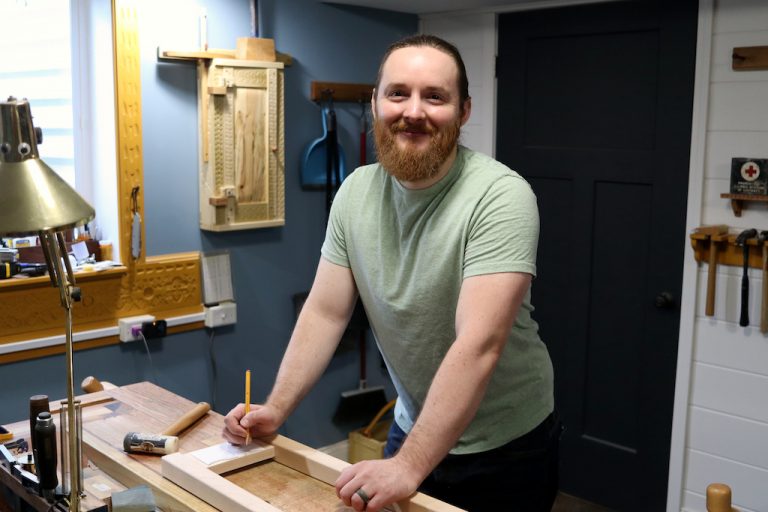
Question #1
Tobias: Hi Eric. Please could you tell us a bit about yourself, what is/was your career and a little about your family and how you became a woodworker.
Eric: I am originally from a small town located in the middle of a cornfield. For a sense of scale, my high school class was somewhere around thirty students and that was two towns worth of kids! My career is in research oversight and review. I am married with two cats. I am still living in the middle of a cornfield, but a much larger one now. It is the “big city” compared to my hometown, but it is “Hicksville’ compared to where my wife is from!
As for my interest in woodworking – I grew up in an old house and like any old building, it required plenty of upkeep. My parents are the ones who did the renovation and remodeling work including some of the furniture. From a young age, I would “help” my parents with the house. At first, I held the flashlight or passed dad’s hammer to him and eventually graduated two doing actual work. Additionally, for as long as I can remember, I have always made stuff with whatever was available (cardboard, tape, Legos, etc). I think that my interest in woodworking was a culmination of all these factors.
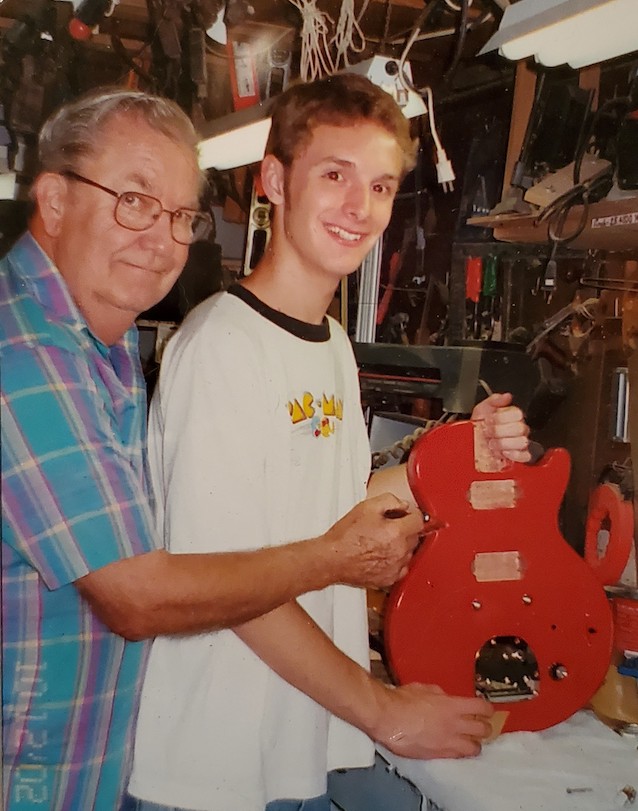
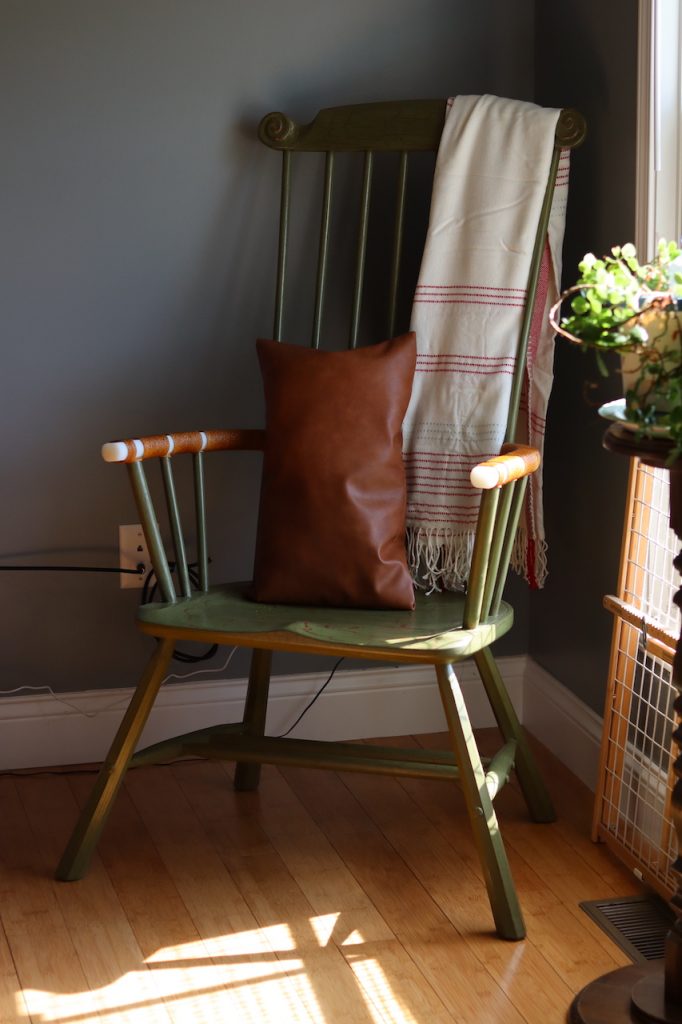
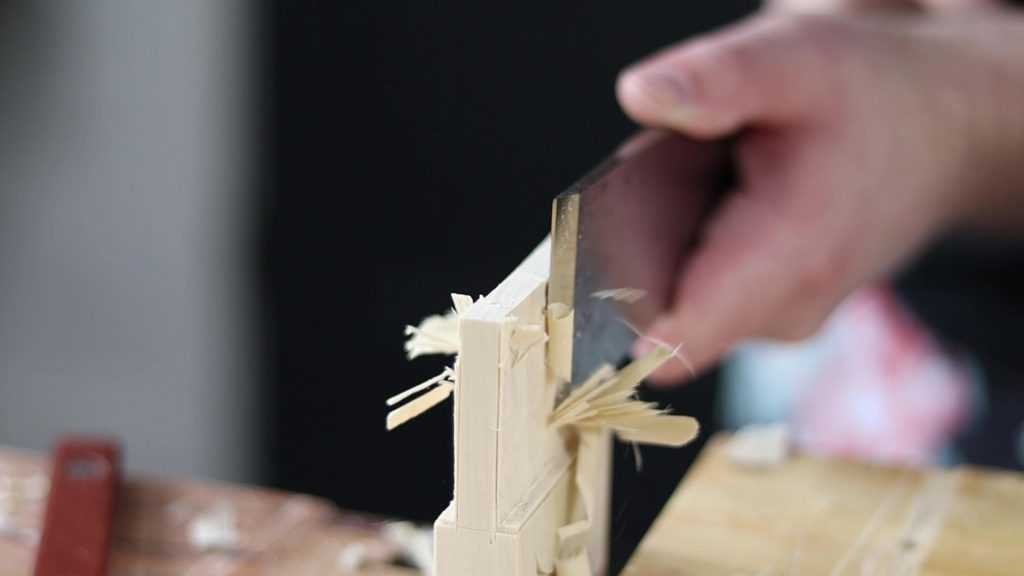
Question #2
Tobias: How did you get started doing woodwork and how long have you been a woodworker?
Eric: I started working with wood in high school. Throughout this time and during graduate school, I was primarily interested in building guitars and built several over those years. After graduate school, I developed an interest in furniture making and built my first coffee table in 2013 with a router, a rasp and determination which our cats have now co-opted as their window seat!
In 2014, I purchased a house and began to focus more on crafting things, enabling me to make the place look the way that I wanted. I have to admit that custom millwork is really hard, especially achieving the correct angles on trim and crown moldings. I was happy at this stage because I only needed to make my projects paint-grade. During this time, I also restored a couple of antiques, built a larger coffee table, an arcade cabinet and a number of other pieces. By 2019, I had immersed myself into the historical side of furniture making.
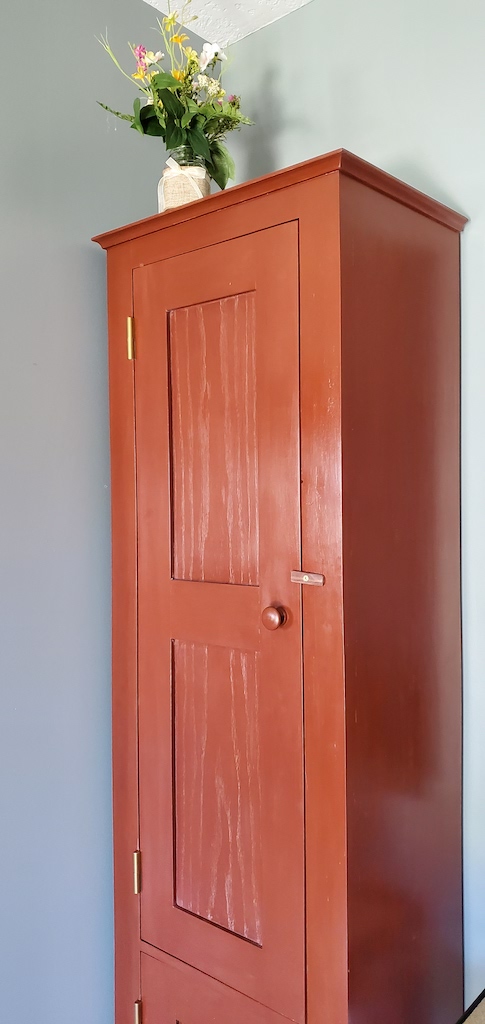
Question #3
Tobias: What was the first item you ever made and which is your favorite piece?
Eric: The first bit of woodworking that I can remember doing was building pinewood derby cars with my dad when I was a Cub Scout and the first piece of furniture that I built was a hanging shelf.
I took woodshop in my sophomore year of high school and the hanging shelf was my final project. I distinctly remember the teacher saying: “I would have given you an A, but I marked you down because it is not square”. My response of “but that was the piece that you cut…” did not help my case. The teacher would not let us use the woodshop table saw, so they made the machine cuts for us. I do remember asking if the board was straight we he gave it to me and he told me it was fine. Alas…it was not fine! I gave that shelf to my grandmother and she loved it. It eventually made its way back to me and it currently hands in my shop. I would like to build another of these shelves at some point, so that I can have a visual representation of what I have learned between then and now. Is it too late to go back to my school and get a retro-active “A”?
My favorite piece is definitely my workbench, mostly because I had no business in attempting to build it with the limited skills that I had at the time.
It is a Scandinavian style bench built following Tage Frid’s instruction, except that I accomplished it entirely with hand tools. Having near zero experience with hand tools, it took months to complete. It is still together and I love it! Over time, I have made some minor changes to the bench (tool rack, drawers & a third vise) as I have better understood my workflow. I do plan to add some storage underneath it, similar to what you find on the Shaker Bench in Scott Landis’ Workbench Book. The area under my bench is a constant mess that I have ignored until now. Overall, I am still happy with how the bench turned out.
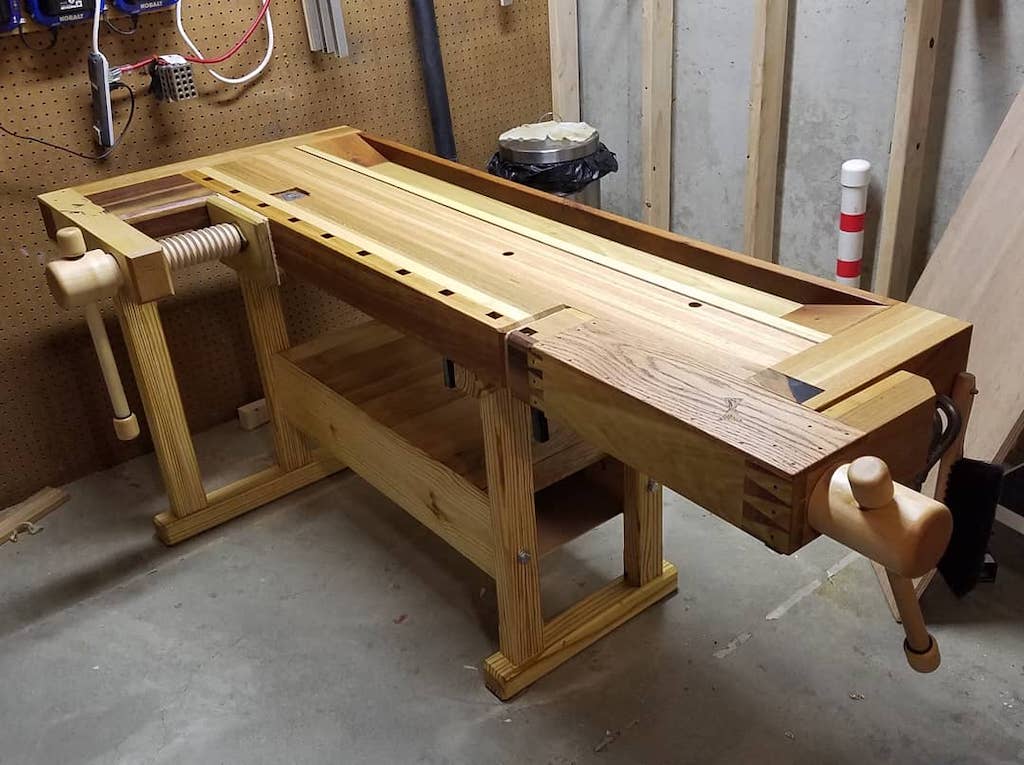
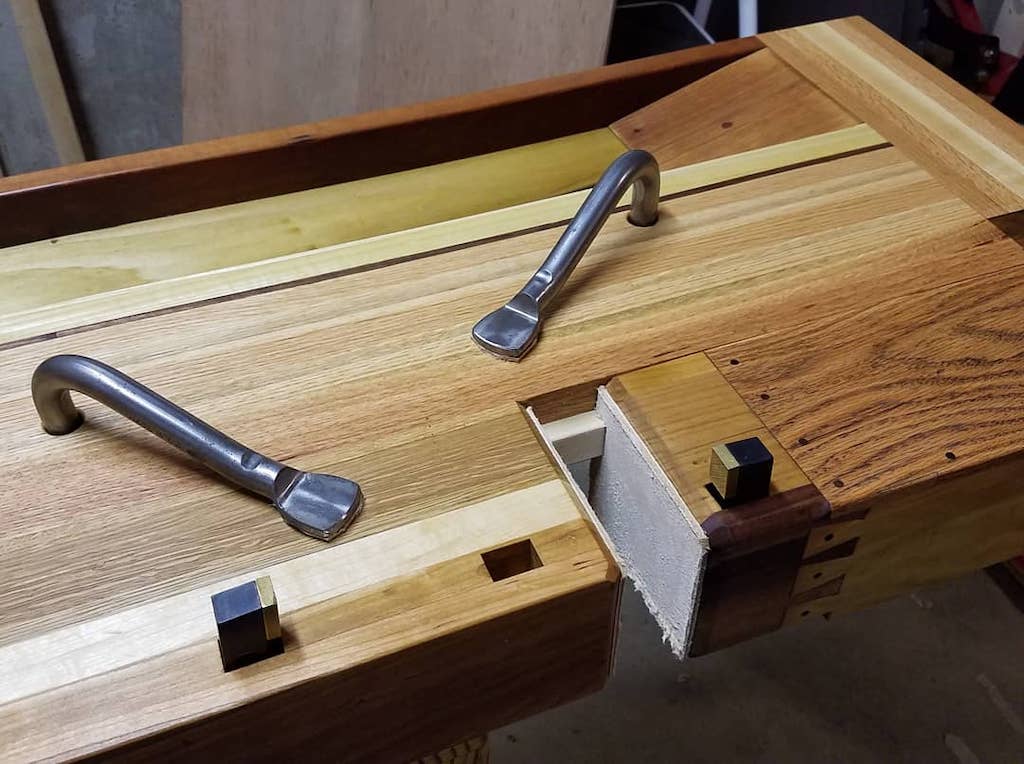
Question #4
Tobias: Which style of furniture do you enjoy building the most?
Eric: I tend to be drawn to 18th and 19th century furniture styles, particularly those with quieter aesthetics. The pieces documented in Joshua Klein’s book “Hands Employed Aright” are good examples of these. I also enjoy vernacular and country style pieces. One of the things that I find truly enjoyable is trying to recreate some of the conditions under which these styles of furniture would have been made. I guess it is sort of akin to experimental archeology without the academic rigor! Let’s be clear, I am not giving up air-conditioning, electric lighting or deodorant! I like to focus on a particular tool set, application of techniques and/or specific materials and see what happens. Most of what I make is not about the piece itself, it is entirely about the experience. In the end, some pieces are kept and some are run through the band saw. With any luck, I learn something that I can later apply.
One example of this is that I have been experimenting with adding wedges to dovetails, a variation that I have not been able to source much information on. I was interested in figuring out for myself as to why this process was historically not more commonly used. I started adding wedged dovetails to my projects, trying to cut the joint the way that they would have in the past. I found that cutting a standard dovetail and cutting a wedged dovetail took about the same length of time and effort. The only real difference between the two is that on the wedged variation, you need to leave a gap between the top of the pin and the top of the tails so that the pin has room to expand when a wedge is driven in. Angling the saw slightly when cutting the tails can achieve this gap, so there is therefore nothing extra that is required in order to cut the joint.
After some experimentation with this style of joint, I found that it simplifies the glue-up process and I suspect that this is the reason why it was used.
With wedges, you can dry-assemble, square the piece and only then lock everything together by inserting a wedge. Any glue that is added can be done to just the wedges or their kerfs and therefore you do not have to contend with glue induced time constraints. Granted, this is conjecture and I do not think I can say anything conclusive about why it was done. The exercise was beneficial to my own work as I had found another way to make glue-ups as stress free as possible.
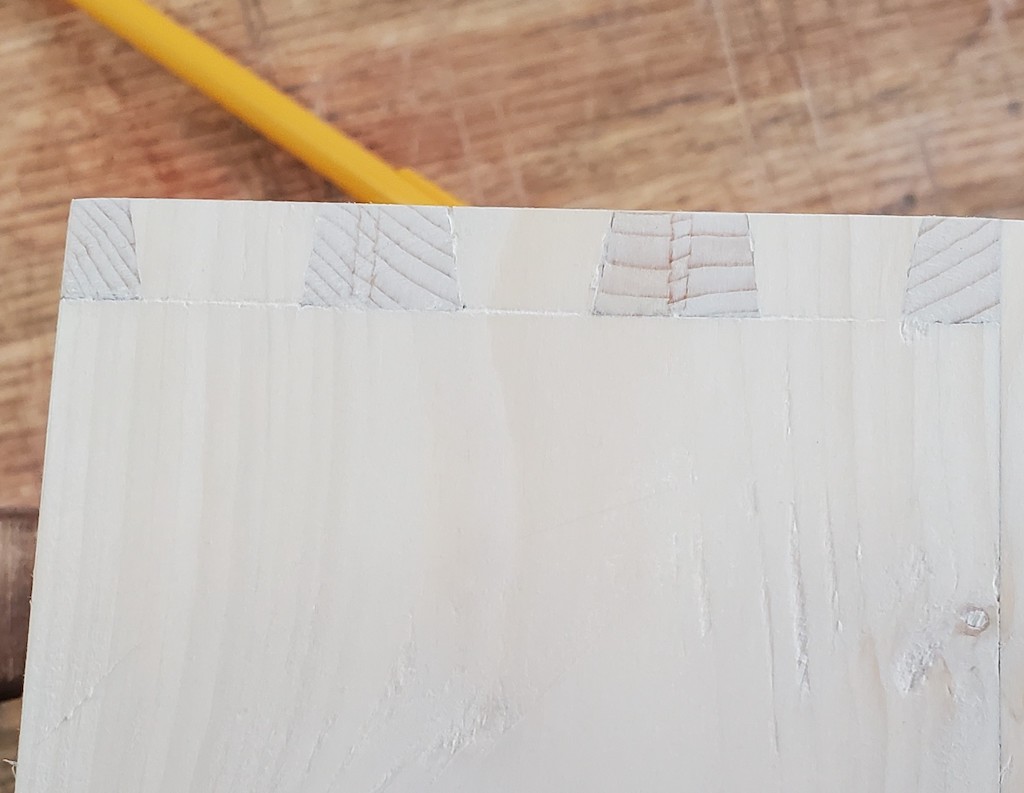
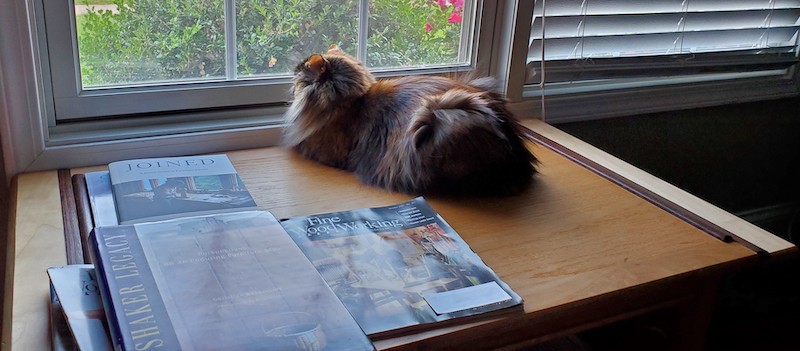
Question #5
Tobias: Which are your favorite local lumber species and which are your favorite exotics to work with?
Eric: I try to stick with working in softer woods. I primarily work with hand tools, so I want to make it as easy on myself as possible. I also prefer the look of lighter toned woods. Poplar and the Soft Maples for domestic lumber are two of my favorites. Personally, I think that poplar gets a bad rap in the looks department and I enjoy it both painted and unpainted. Add a little oil and the and I feel that the look is hard to beat.
White Pine is another species that I like, especially with a hand planed finish and I tend to save it for smaller items, so that I do not need to deal with many knots.
Curly Maple is my go-to when I require a more refined aesthetic in a furniture piece. The same goes for quarter sawn White Oak. I do find that the flecking is a little too much on larger surfaces for my taste, so I usually save it for accent pieces and I also use Walnut as contrasting pieces as well.
I have not worked with a lot of exotic lumber. A few months ago, I made a marking knife from a spade bit with a Black Palm handle. It was a challenge to work with and was a splintery mess, but it felt wonderful in the hand once it was smooth. It is a neat looking wood, (grass). I have plans to use it as drawer pulls, wedges and plugs, but have not found the right project for it yet.
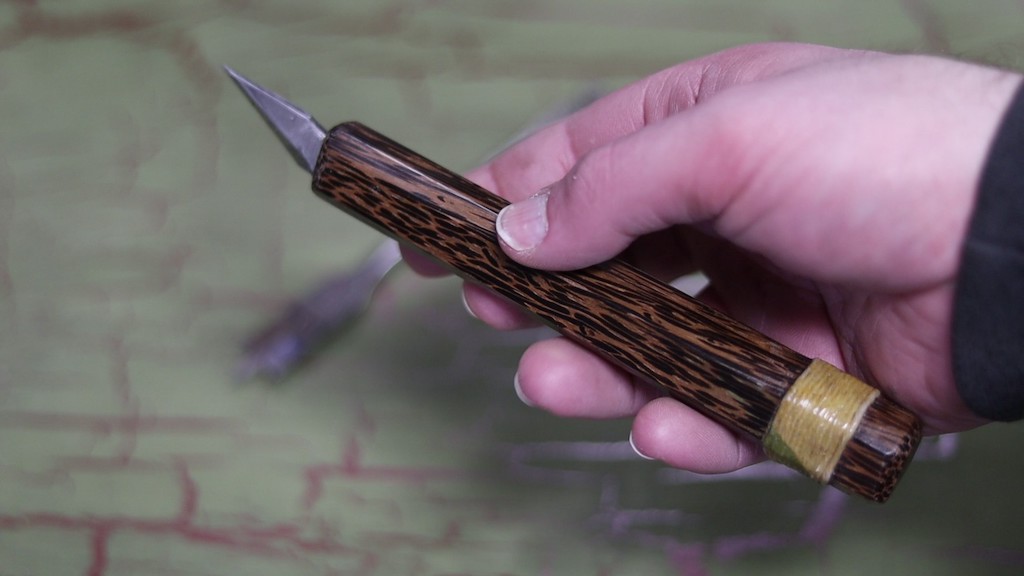
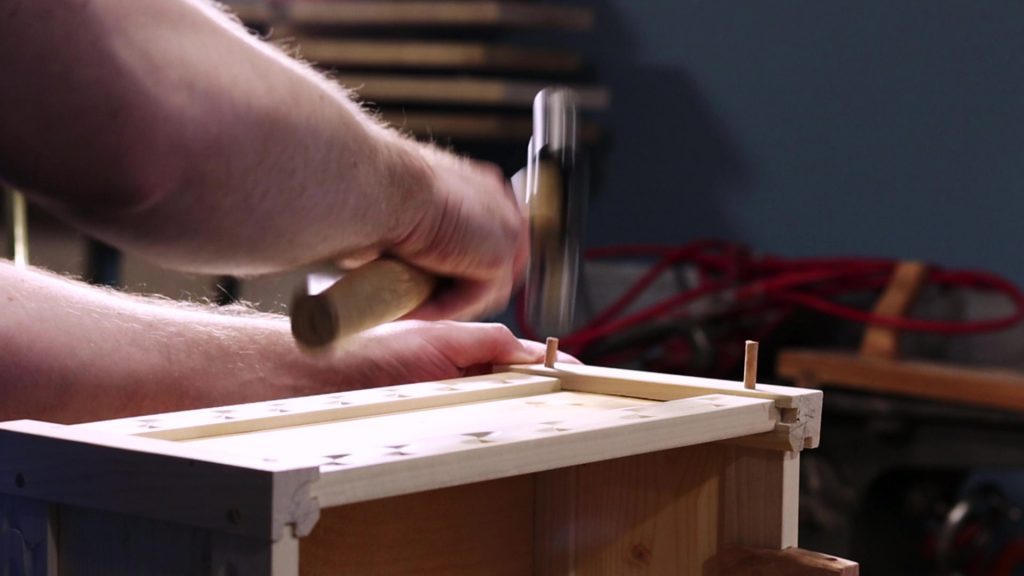
Question #6
Tobias: Please list your most used hand tools and tell us why they are your “go-to” tools.
Eric: I have a framing chisel with a lowered bevel that I use as a paring chisel. This was a game changer when it came time for fitted joinery. With it, getting a tenon perfect became much easier. A Veritas bevel-up jointer plane is my most used hand plane. Lately, I have been enjoying Japanese pull saws and really like how light they are. My Ulmia single iron wooden plane is also a firm favorite. I added a deep camber to the blade and use it as my fore plane. It is the first plane I grab when I need to remove a lot of material.
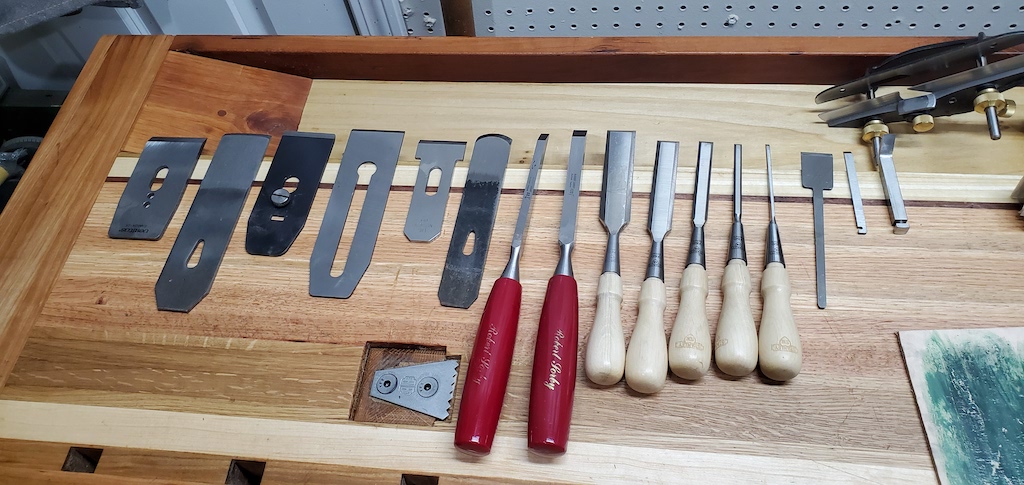
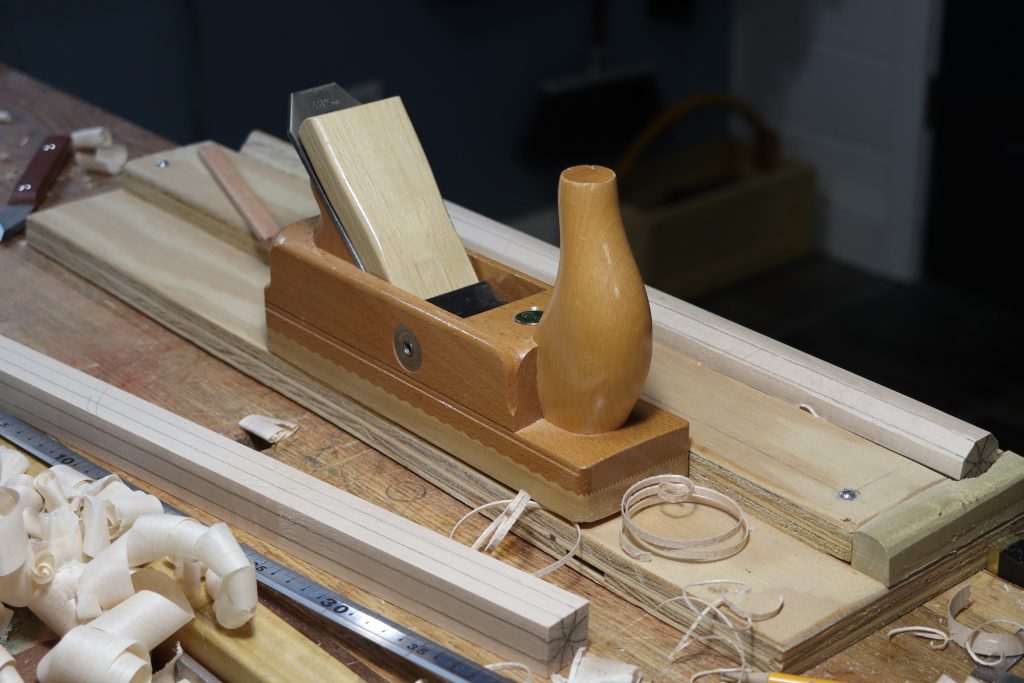
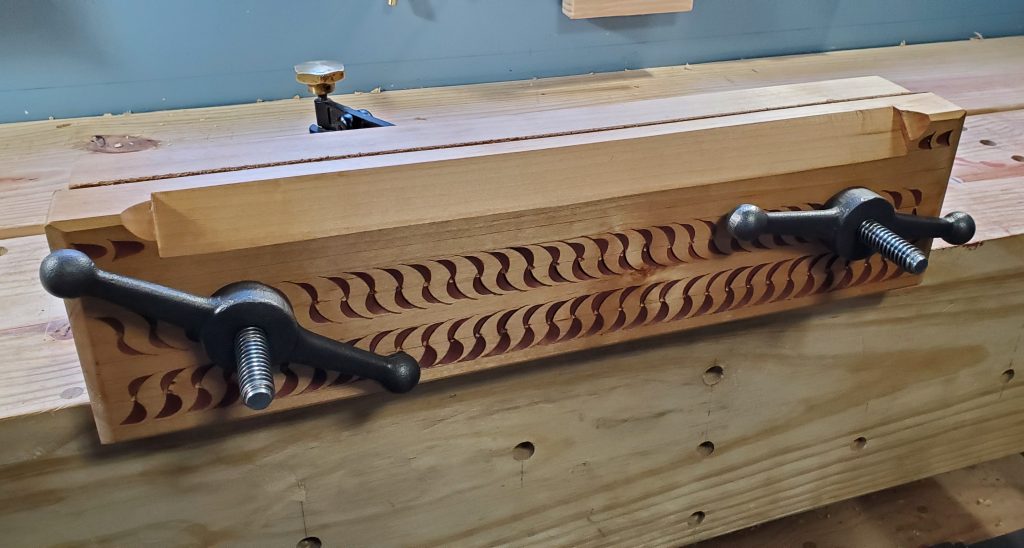
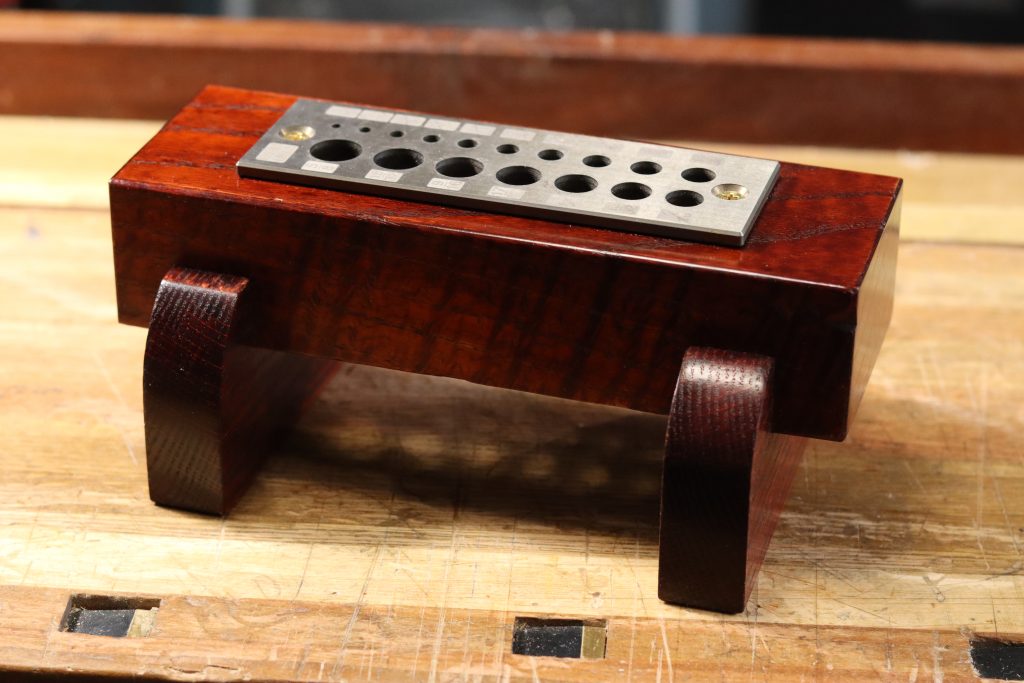
Question #7
Tobias: Can you list your favorite power tools and machines and tell us why?
Eric: In the shop there is a 12″ Craftsman band saw, a DeWalt planer and a Walker-Turner jointer from the 50s. They are mainly used for heavy stock removal when I have a lot of components that I need to work through. I am sure that many woodworkers would be appalled with my current setup and tolerances on the machines, but they are good enough for me, as I just need to get close so that hand tools will take me the rest of the way. I really like that the machines allow me to put less effort into the stock prep and get to the fun parts much quicker.
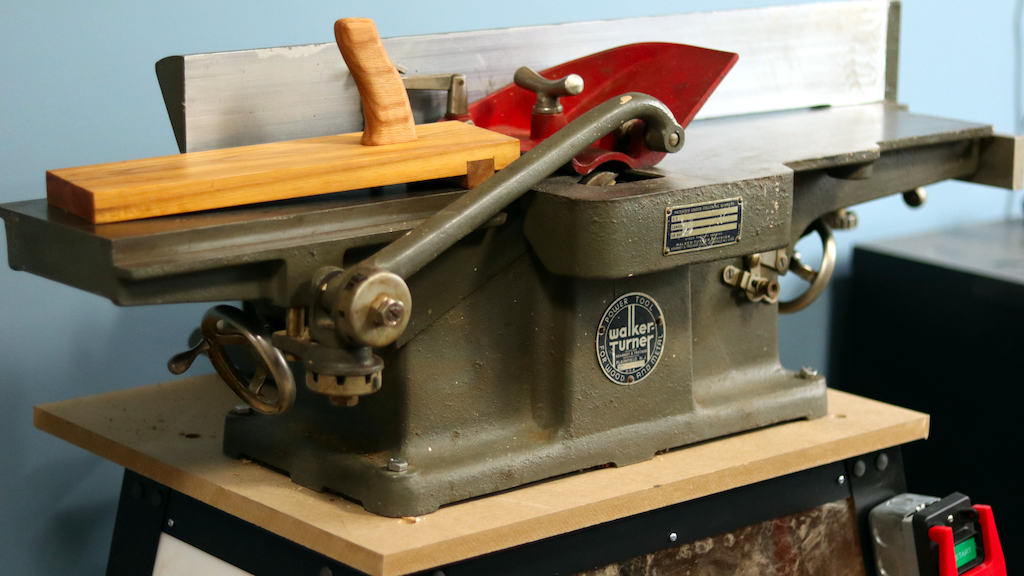
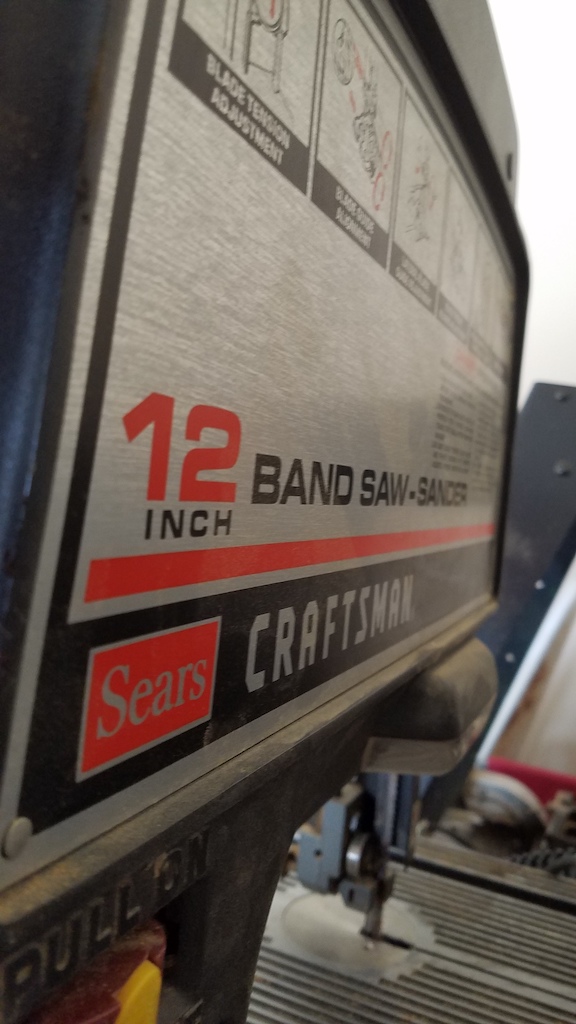
Question #8
Tobias: What is it about working with wood that you find most enjoyable?
Eric: Wood is an amazing blank canvas and I can pretty much do whatever I want with it. From start to finish, it is just fun! I get to make something, it is useful and looks how I want it to look. That is very hard to beat.
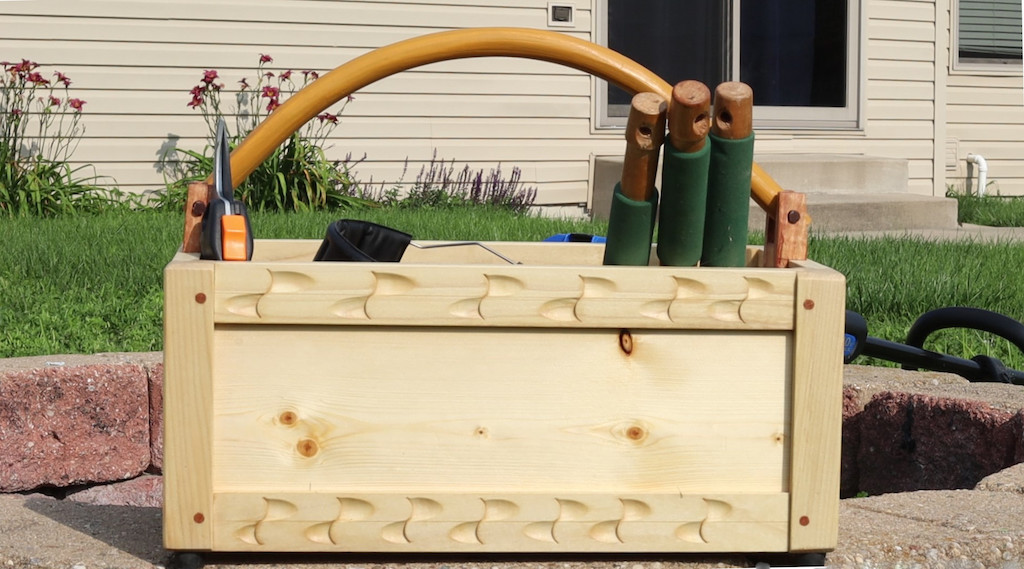
Question #9
Tobias: What type of workshop do you have, how has it evolved over time and why?
Eric: I have a basement workshop that is predominantly set up around the use of my hand tools. My first shop was a 2 x 4 and a plywood bench on wheels in a corner of my garage. It held a miter saw, a job site table saw and a bench top planer. I kept my routers, drills and various bits and blades inside a closet in the basement. I eventually grew tired of the heat, cold and the constant running up and down stairs to fetch or put away my tools. I decided to move inside and the only space available was roughly 7′ x 8′, just enough space for a bench and a tool chest. it was at this point that I jumped into hand tools.
When we moved house, I had the opportunity to set up a bigger workshop. I am now in a space approximately 12′ x 15′. I inherited a band saw and a small jointer that I was able to setup up in this space as well. The heart of my shop is my workbench where I do the bulk of my work.
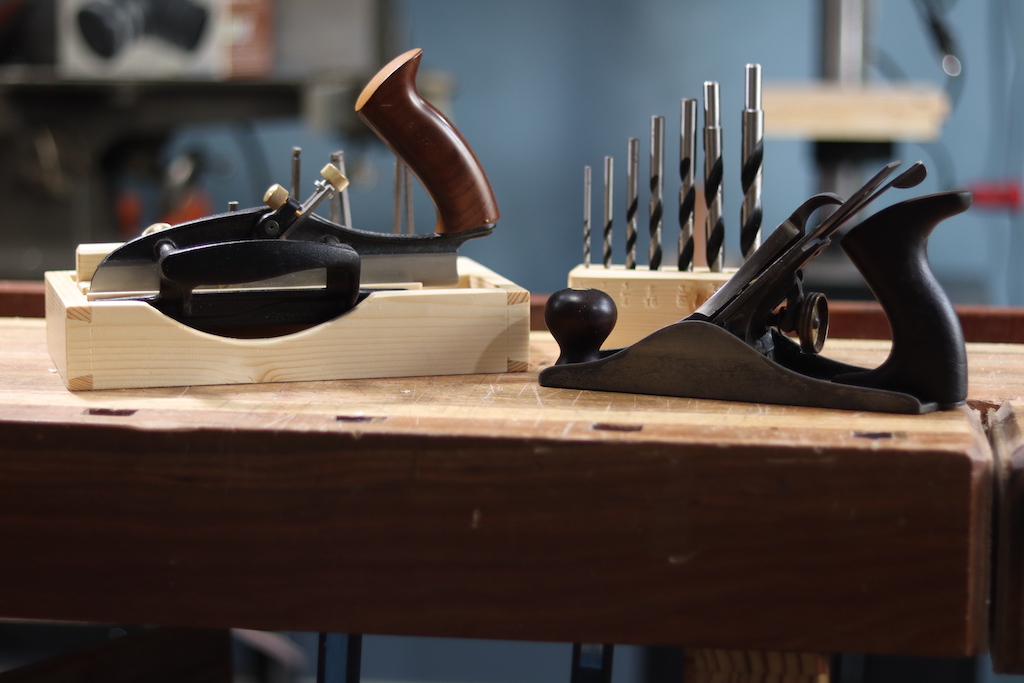
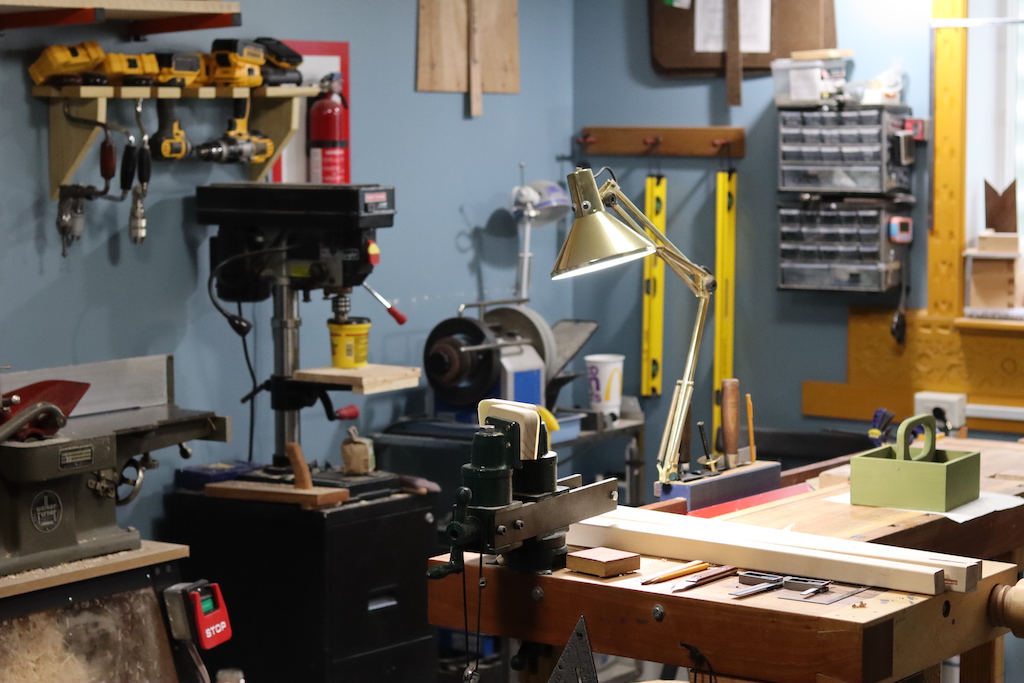
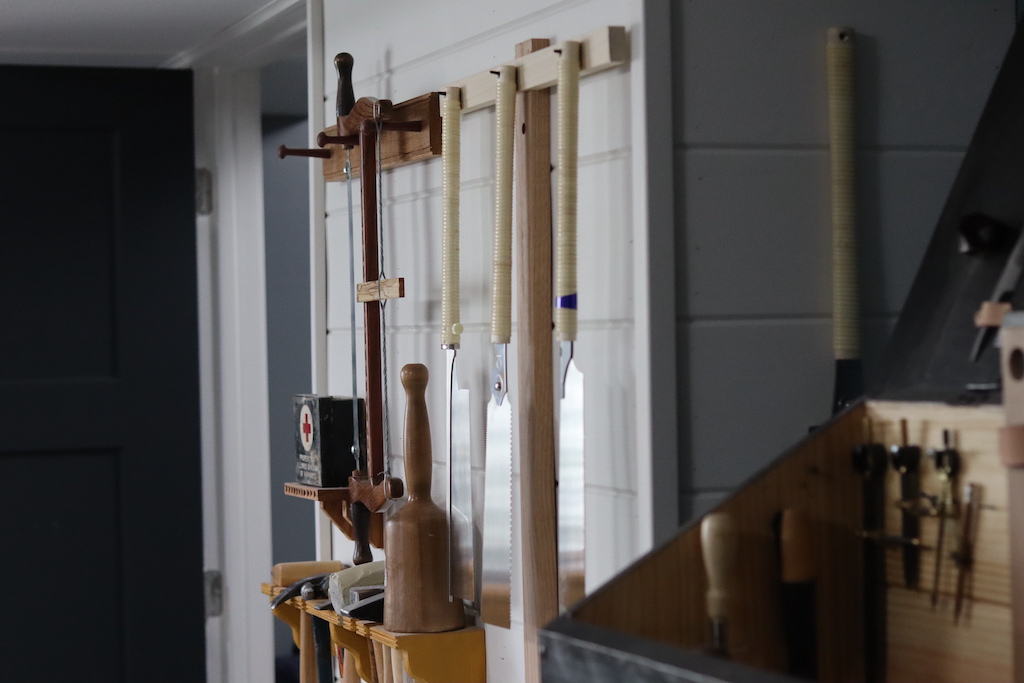
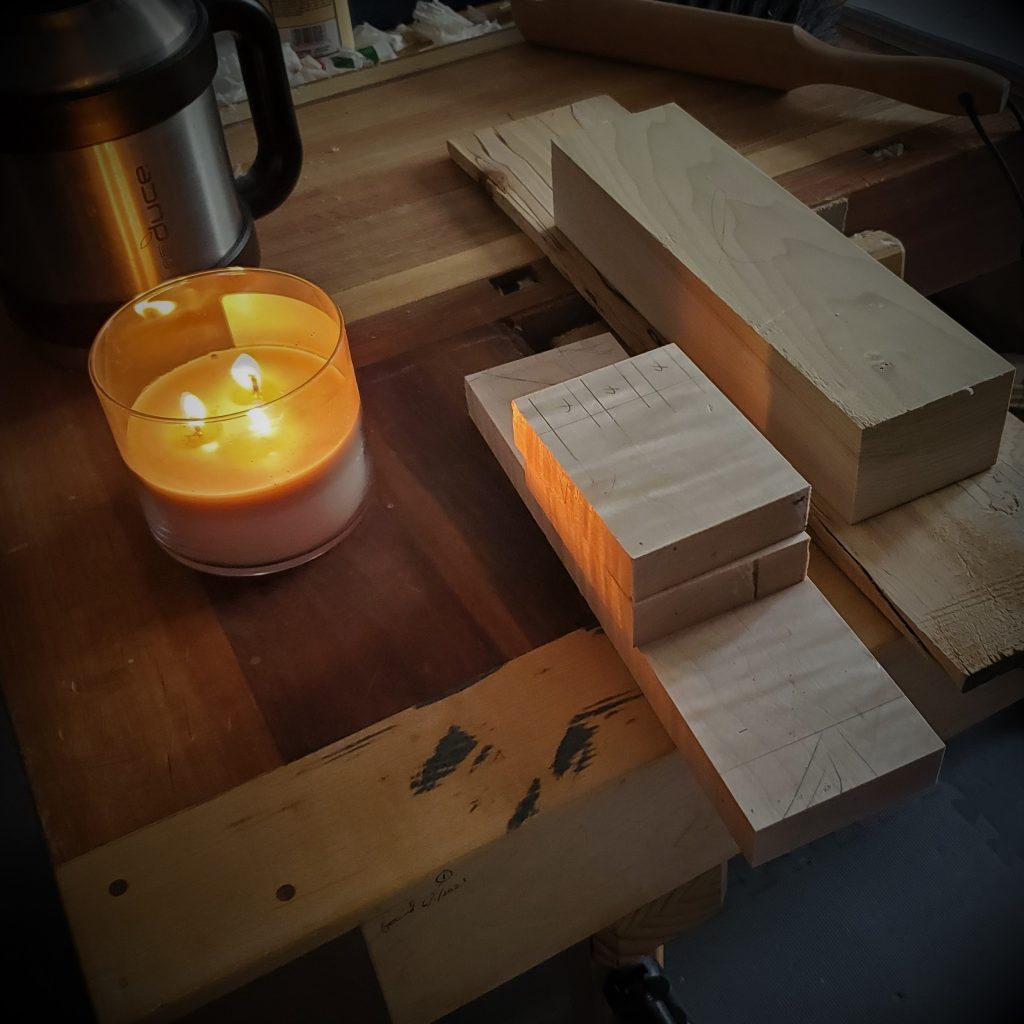
Question #10
Tobias: What is your clamp line-up and why?
Eric: We all know that people say that you can never have too many clamps. I think that I am the exception to the rule. I use about four clamps on a regular basis. I have increasingly been moving towards using joinery that can hold itself together without the need for glue. I think that this probably comes down to the fact that I would rather keep on working on something than having to wait while it sits in the clamps to cure. Once I get going, I do not like to stop.
I do have a few racks of clamps that I keep in a storage closet in case I require them for panel glue-ups and the like. Even with these types of operations, I find that I need less clamps, as I am trying to make more use of spring joints. Additionally, from a design perspective, I have noticed that I am using joinery in place of glueing up boards, for example by adding more panels to a frame or using tongue and groove boards to span wider areas.
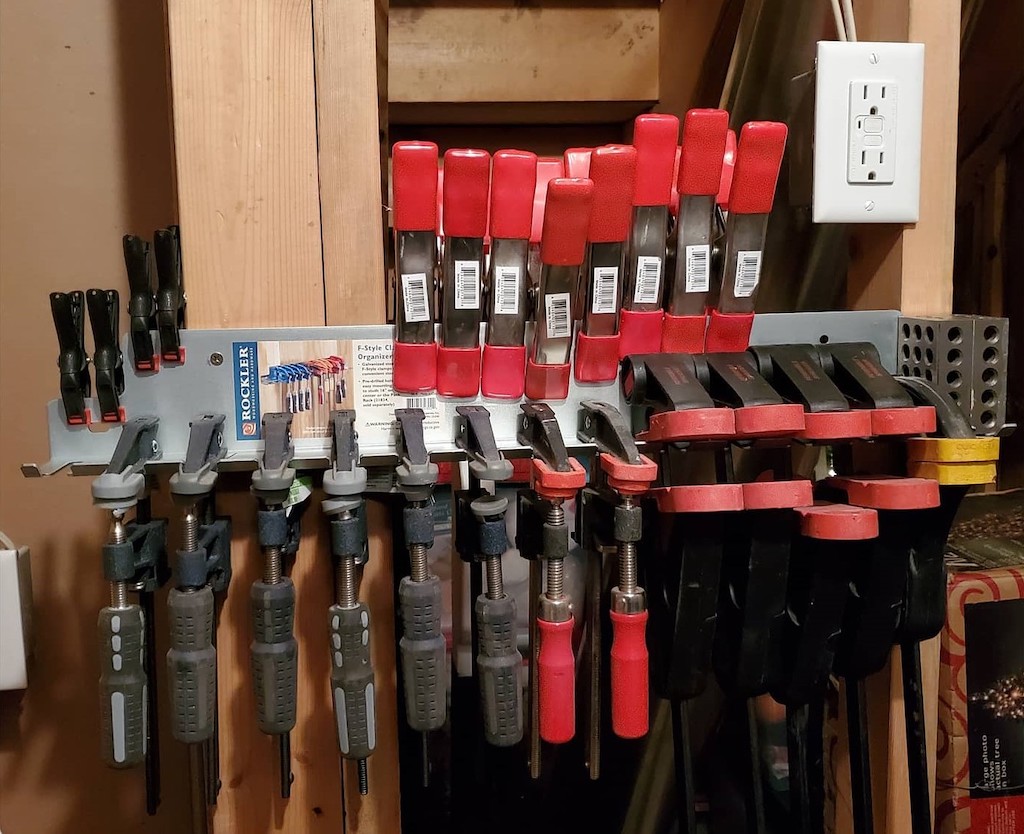
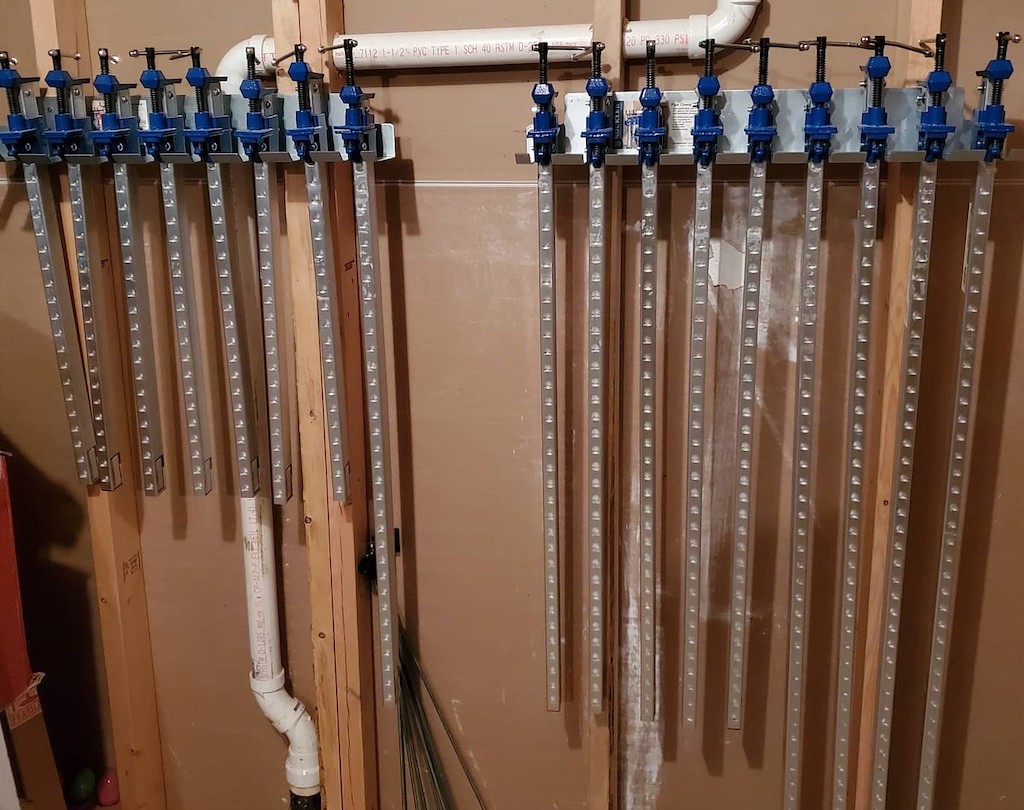
Question #11
Tobias: Which adhesives and glues do you use and why?
Eric: You would have guessed from my previous answers that I do not like using glue much. However, I do have a bit of everything in the shop – hide glue, yellow glue, white glue, 5 minute epoxy and super glue.
I like white glue for fixing little mistakes like glueing back a chip or mixing with sawdust to stick in a gappy dovetail. It seems to discolour the wood less than other glues that I have tried. I generally grab whatever I can get at my local hardware store, which is usually Elmer’s.
I use liquid hide glue for joinery work. The ability to hit the undo button on the glue-up is a wonderful feature. It also makes it easier for me to get that perfect fit, because it will lubricate the joint more so than just swelling the fibres like PVA glues. I use hot hide glue as well, predominantly for veneer work, but for my general joinery work the liquid hide glue is easier. I use both Titebond and Old Brown Glue, but prefer Old Brown to support the smaller craftsperson.
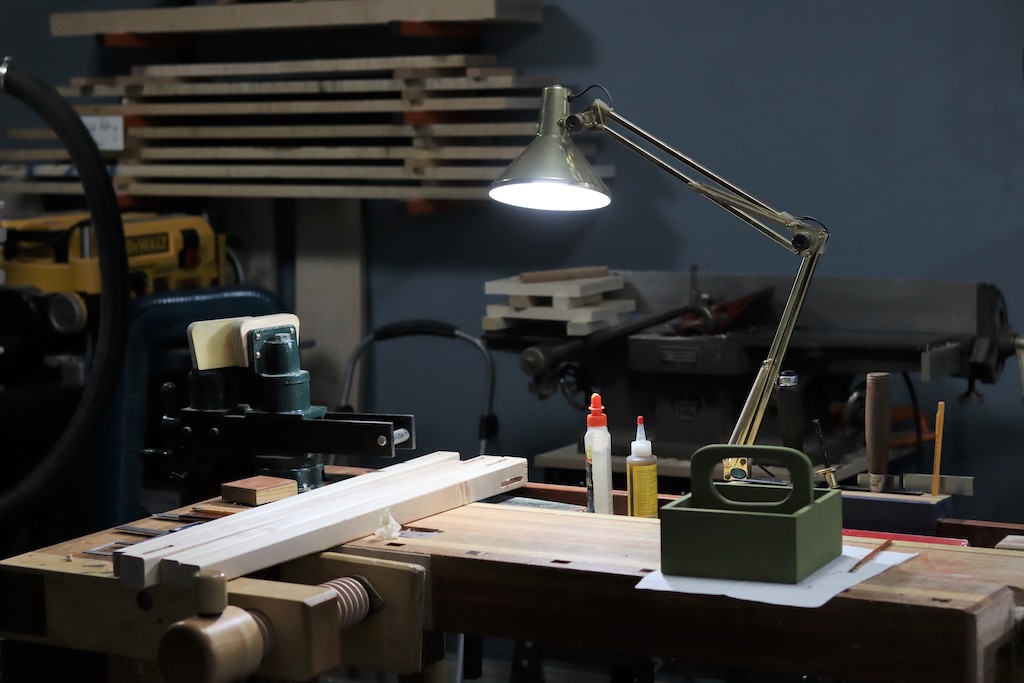
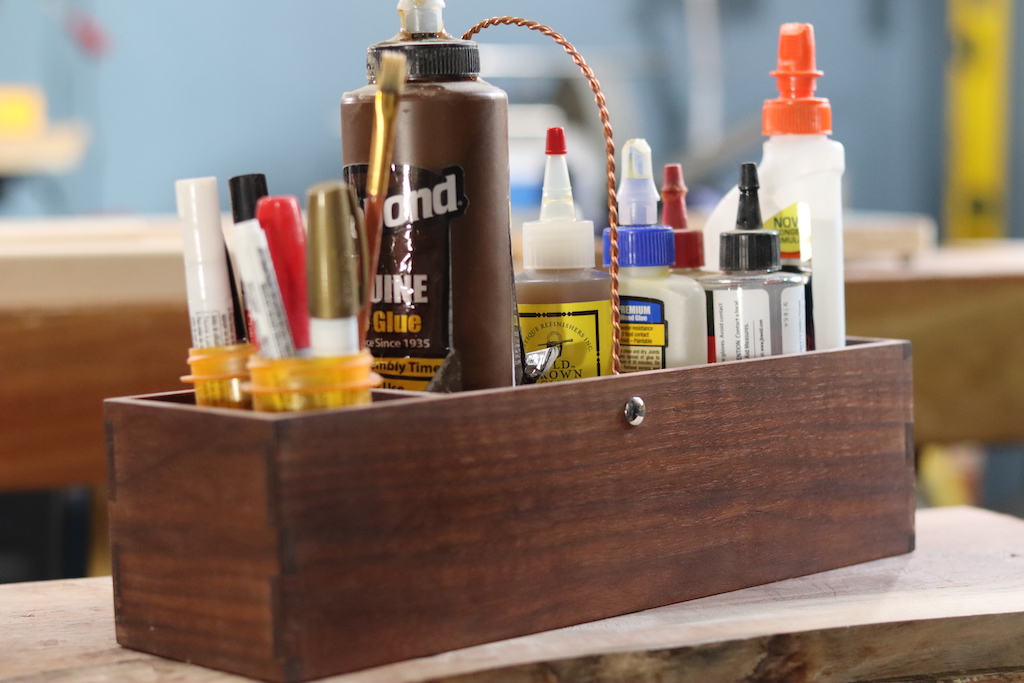
Question #12
Tobias: Which woods (exotic and local) have you not yet used and why are you interested in building with these species?
Eric: Sycamore is on my list, although I may have used it before. I challenged myself to build a cabinet that did not use any glue, screws or nails and the panel that I made for that cabinet’s door might possibly have been spalted Sycamore. Whatever that wood was, I found it a pleasure to work with. If it was indeed Sycamore, I would really like to use more of it.
I would also like to give Sassafras a try. It looks similar to Oak and about half as hard. There are a few 17th century style carved pieces that I would like to make again and I reckon Sassafras would give a nice balance of looks and workability for these types of pieces.
For exotics, I would really like to try genuine Mahogany. It appears to be soft enough to work easily with hand tools and dark enough to use as a contrast to the lighter shade woods that I typically use.
I have been working on a design for a miniature chest of drawers that would sit on a dresser to hold jewelry or on a desk for stationary. I want to make the case and drawer fronts from a lighter wood and I wanted to use a darker wood for the sides of the drawers. I was thinking that maybe Maple and Mahogany would work together for this piece.
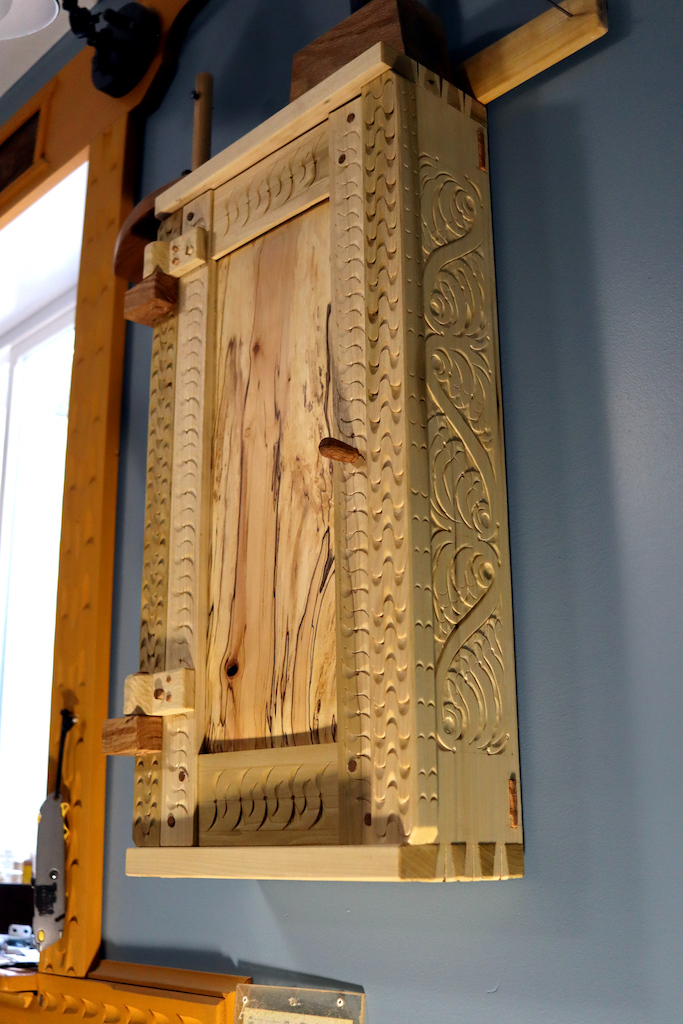
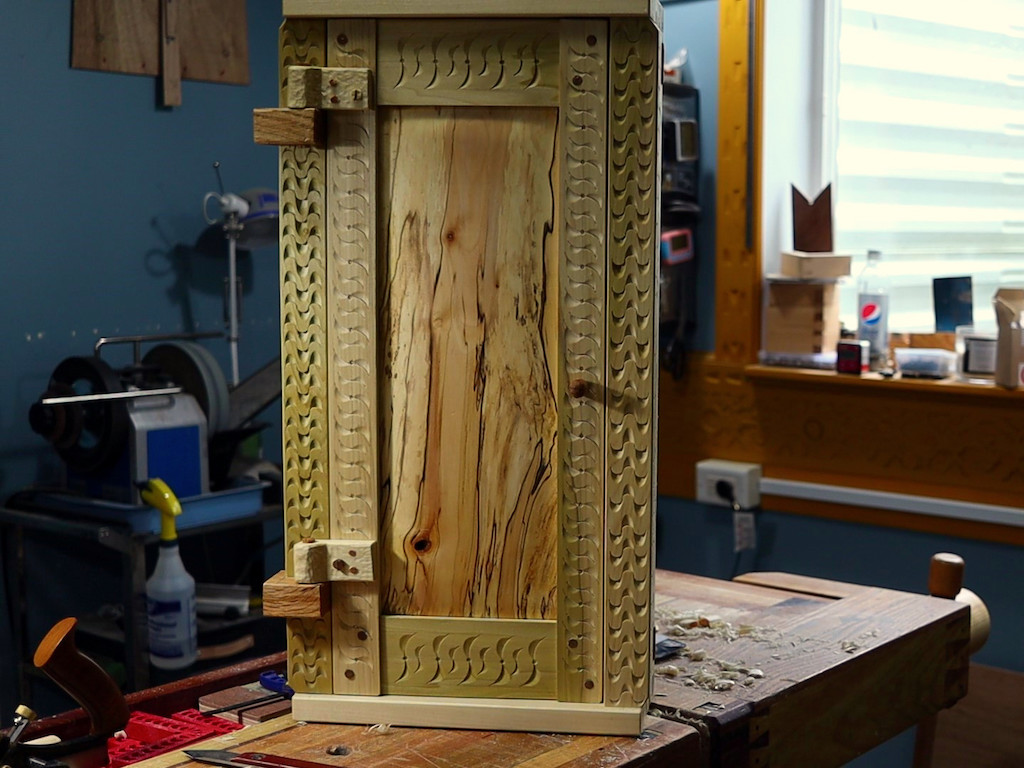
Question #13
Tobias: What and whom are your sources of inspiration for your craft?
Eric: Christian Becksvoort for sure. The information and experience that he offers is very hard to beat. I enjoy the way that Tage Frid and Frank Klausz approach woodworking operations and these seem natural to me. Whenever I am looking to learn a new technique or get clarification on something, one of the above three usually has the answer.
Peter Follansbee is another. His carvings are fun to do, but I have derived more from his writings on stock prep and working with what the log gives you. Although I am using kiln dried lumber, I like to try and apply that type of mentality to my projects.
Gary Bennett, Jimmy Diresta and Laura Kampf approach their craft from an artist’s perspective. It seems that woodworkers typically don’t see themselves as artists. These three demonstrate that they are one and the same.
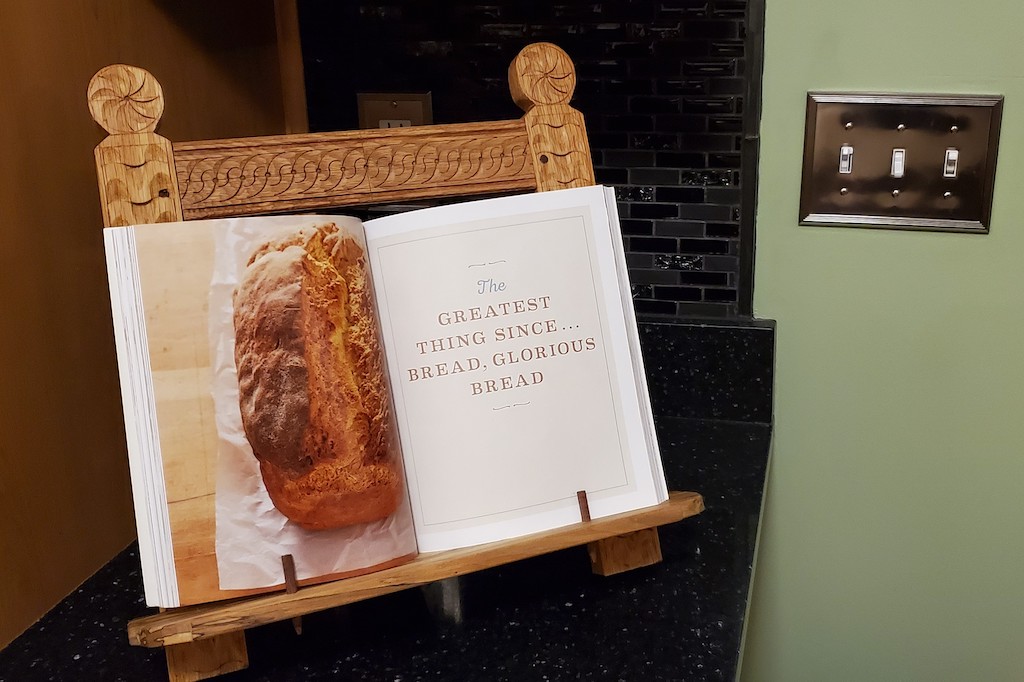
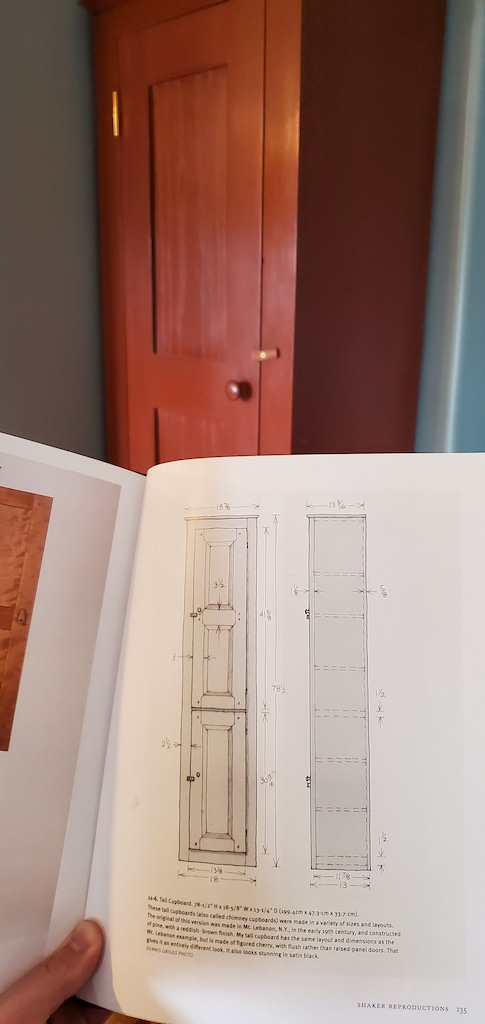
Question #14
Tobias: How do you design your pieces, Do you use CAD or SketchUp or do you draw out by hand?
Eric: It all depends on what I am going to build. For most of my personal projects, I just start building and figure things out as I go along. My garden tote is an example: I had an image in my head and I wanted to build it entirely with frame and panel construction. Choosing the joinery and jotting down minimum internal dimensions was the extent of the design phase. The final sizes of all the individual components were dictated by what I could could get out of the scraps that I had set aside for the project.
Improvising within constraints is how I like to build most of my pieces. It makes each one an enjoyable and creative exercise.
There are other pieces where I want to have a very clear idea of the piece, before I set foot in the workshop. For these pieces, I do plenty of sketches and often draw out specific elements in full scale. I did this with the E-Reader stand that I made. I found a photo of a Victorian era bookstand and wanted to build something similar. This project was drawn and redrawn a number of times until I had something that I liked.
I do use SketchUp on occasion, usually to figure out how something will fit into a room or test out placement of a piece in specific space. I would like to make more use of SketchUp, but drawing by hand is much faster for me.
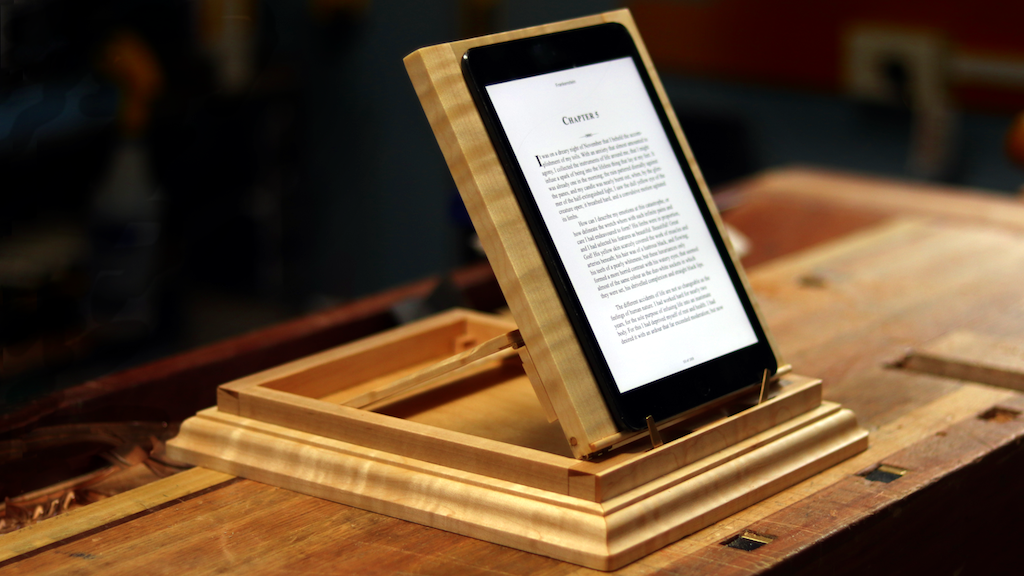
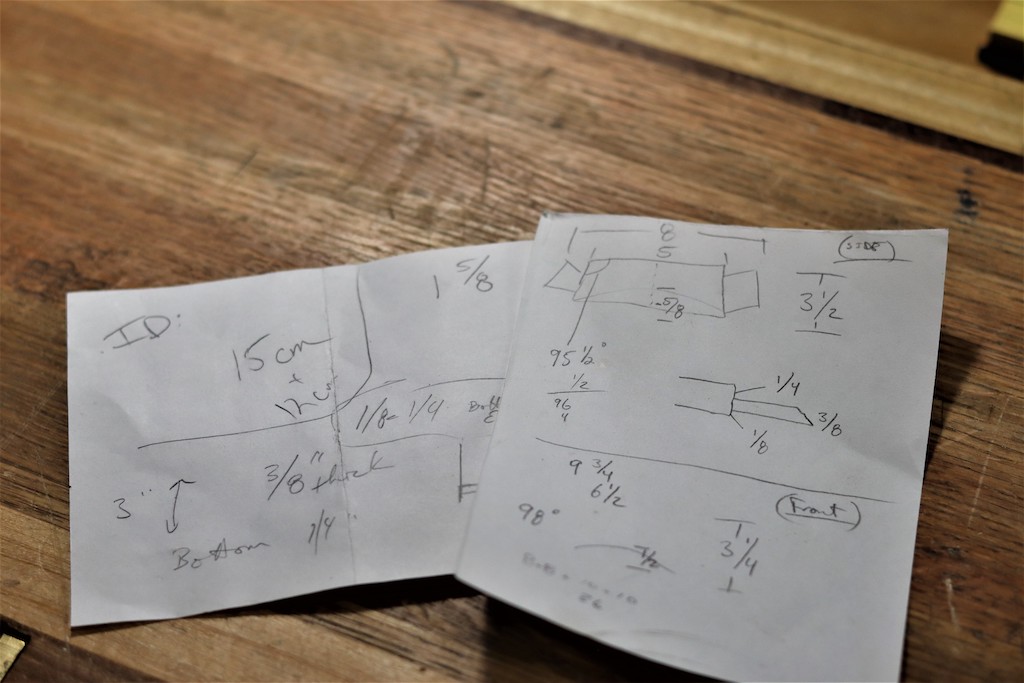
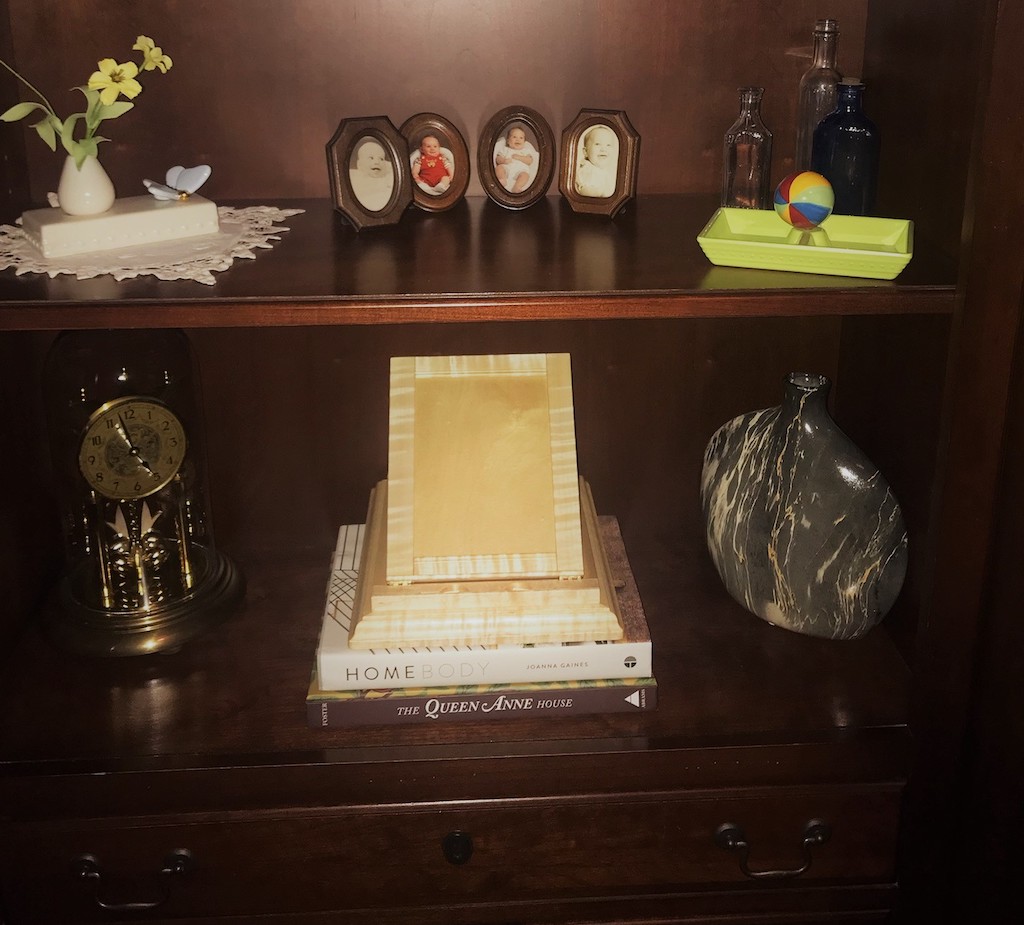
Question #15
Tobias: What are your finishing regimes, what products do you use and which are your favorite processes?
Eric: Peter Nicholson’s 1826 book “Practical Carpentry, Joinery and Cabinet-Making” has been a big influence on the way I prepare and finish wood.
Nicholson’s process was to plane the wood smooth, scrape away the plane tracks, sand the surface, wet the surface to raise the grain and the sand again. I generally follow the same routine as it solved many of the issues I had in surface preparation. I don’t do this for every surface, but it tends to be the roadmap that I follow.
With finishes, I prefer ones that are easy to apply, maintain and repair. All my finishing is done in my basement, so low odor is a must. My standards are usually linseed oil, milk paint or shellac. Zinsser Seal Coat works when I want to use shellac. I add denatured alcohol to make it a 1lb cut and wipe it on with a pad. After the final coat, I typically will go back over it with a wax to even out the shine. (It makes me look like a much better finisher than I really am)
I use paint when I want to add color to a piece or when I mix wood species and need to have everything come together as a cohesive design. Real milk paint (the powdered stuff) is perfect. The first coat always looks rough, but after coat two and some burnishing, it looks fantastic. Milk paint is incredibly versatile, it can be layered to achieve different effects and it can still let the grain show through. From a distance it can look like one color and as you get closer, it can surprise you.
Linseed oil is used frequently in my shop. Tried and True Varnish Oil or Allbacks Linseed Oil-Wax are my favorites at the moment. With Tried and True, I burnish the surfaces with a grey 3M pad before and after each coat. The oil is applied with a rag. I apply the Allbacks mix with a grey 3M pad. I use regular hardware store BLO as well and tend to use it on shop projects or as a way to add color before applying shellac.
I would like to get more into using pigments and dyes, especially to pop the figure in Curly Maple. Oil does a pretty job job by itself. but could stand out more with the right application of colorant.
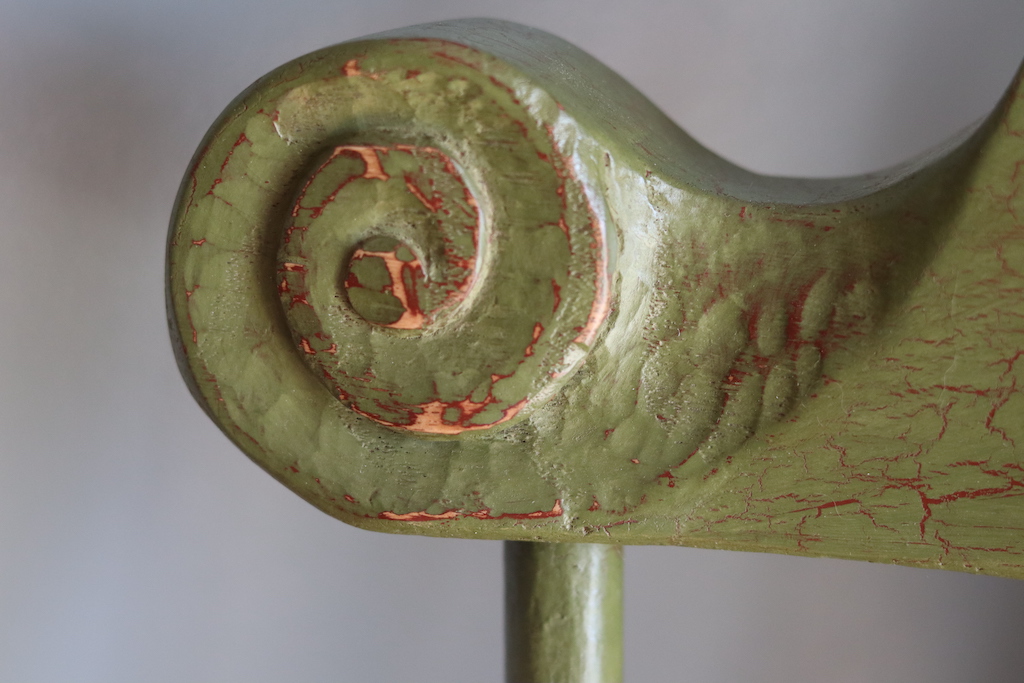
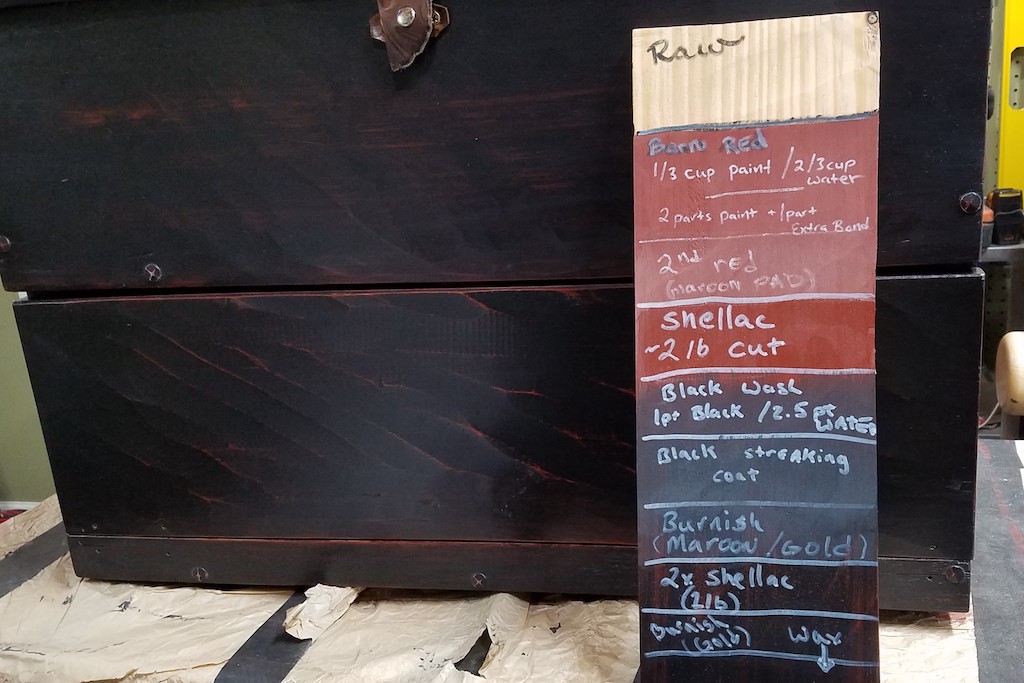
Question #16
Tobias: Which parts of working with wood do you dislike the most?
Eric: The finishing process, as this is where I always get myself into trouble! A piece turns out great and then I go and butcher it with the finish. Moving to milk paint, shellac and oils have helped greatly in achieving a better looking finish. With most stains and varnishes, it was always an uphill battle.
I have read about Japanese craftspeople leaving their wooden furniture without any finish. The finishes are the surfaces left by the tools. Maybe I should start doing this as it would solve most of my finishing dilemmas!
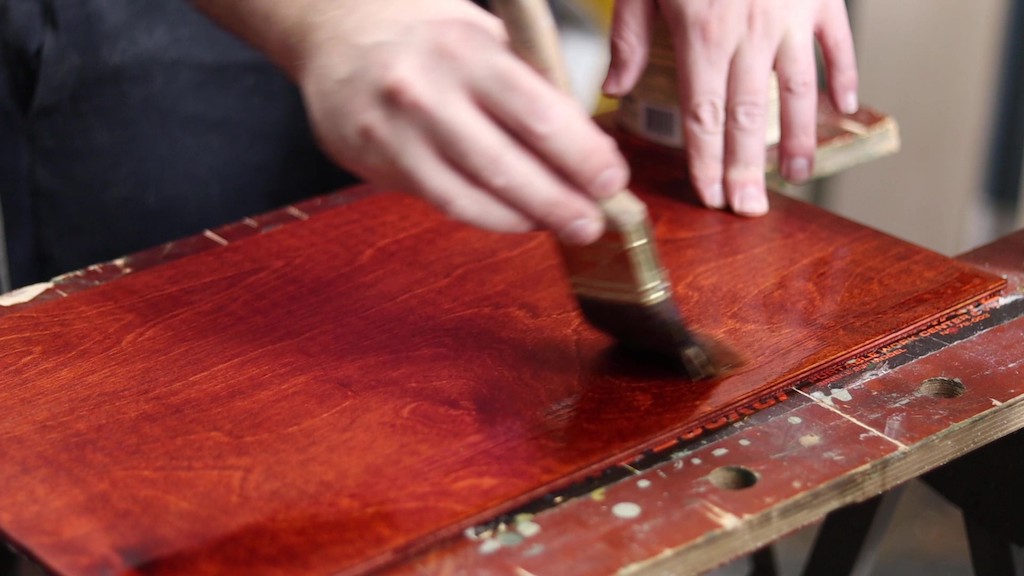
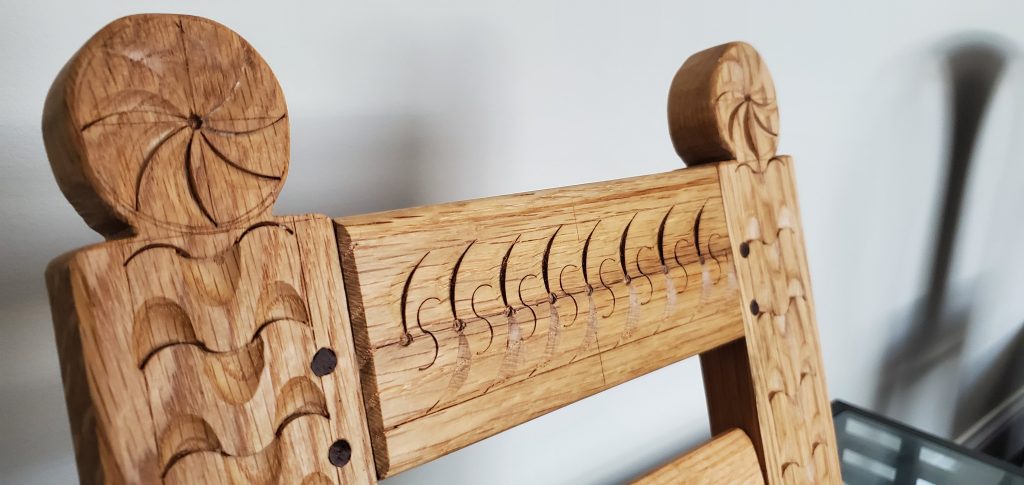
Question #17
Tobias: What is your favorite music to listen to whilst working in your shop?
Eric: I am all over the map on this one! These are my recent plays:
- Dolly Parton
- Hamilton soundtrack
- Gillian Welch & David Rawlings
- Caylee Hammack
- Sara Barellies
- Pearl Jam
- Gaby Moreno
- Letter to Cleo
- Rage Against the Machine
- Bad Religion
- The Little Willies
- Wilco
- Billie Holliday
- Taylor Swift
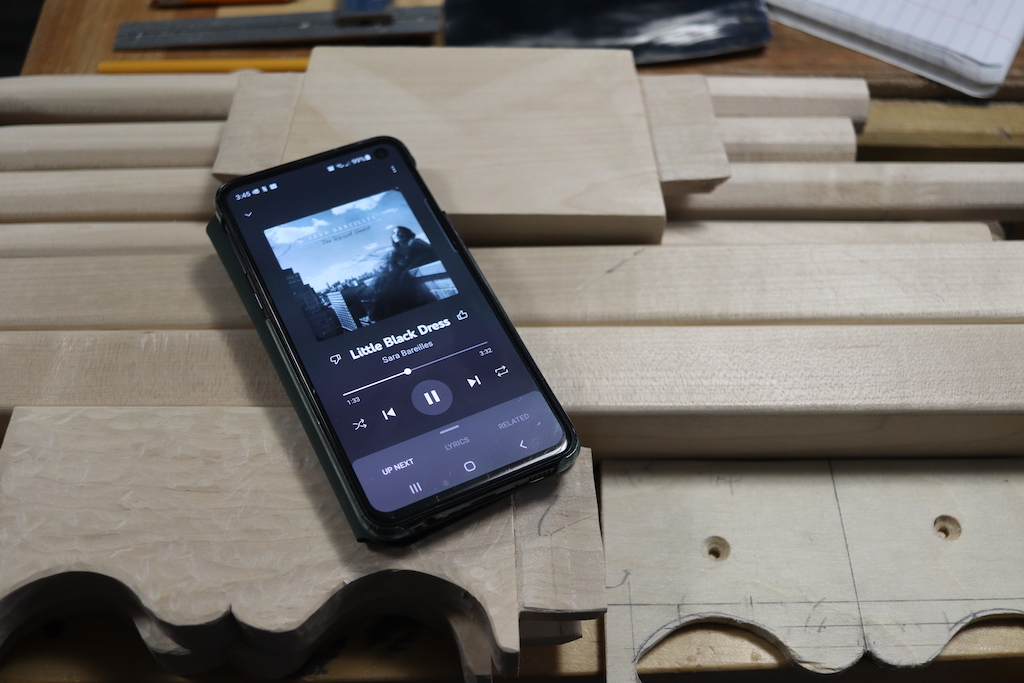
Question #18
Tobias: What is you tool sharpening regime?
Eric: I learned to sharpen by hand and hated doing it, so I bought a Tormek. It was expensive, but it is easy to use and I achieve consistent results.
A strop loaded with green paste lives on my bench to keep edges honed.
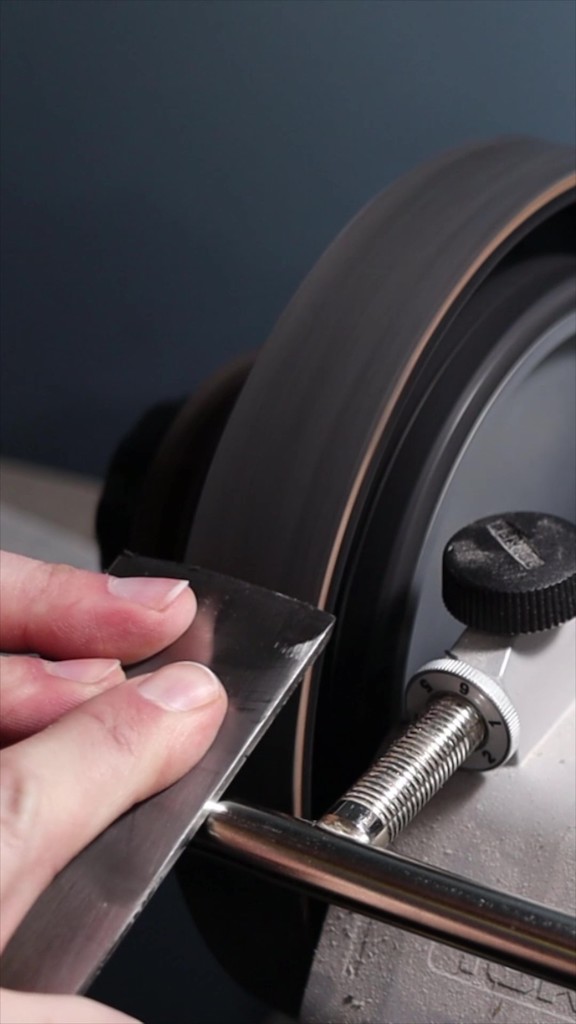
Question #19
Tobias: What custom jigs or tools have you developed for your woodworking?
Eric: The jig that is most used holds thin parts so that I can edge-plane them. It is held in the vice and has a movable fence to accommodate the width of the board that I am working with. I trim the boards by laying a hand-plane on its side. Essentially, it is a shooting board for long grain. It is much easier to shoot thin boards this way. Tool-wise, I have made a panel gauge and a veneer hammer. They were both borne of necessity and were a good introduction to toolmaking.
I am proudest of the scale that I made for my Veritas #7-1/2 low angle jointer plane. On most hand planes, the side and sole are at 90º to each other. On this plane, there is a protrusion on the side to allow accessories to be attached. This makes it difficult to use this plane for shooting. To solve the problem, I made a scale from HDPE plastic that mounts to the side of the plane. It was difficult as I had to work to machine shop tolerances.
Initially I made wooden templates for the overall shape of the scale and for the area that would be removed to accommodate the protrusion. Once they fitted perfectly, I transferred the wooden patterns to the HDPE using a router and various bits. I ended up making the part a few times and refining the process with each iteration. Eventually, I had four or five sets of wooden templates and three final pieces in the HDPE. I also had to modify the screws used to mount the scale to the plane, going through a number of sets of screws getting the perfect length and filing the heads to size. This processed has peaked my interest in pattern making. making a perfect part in wood and then casting it in metal sounds like a lot of fun!
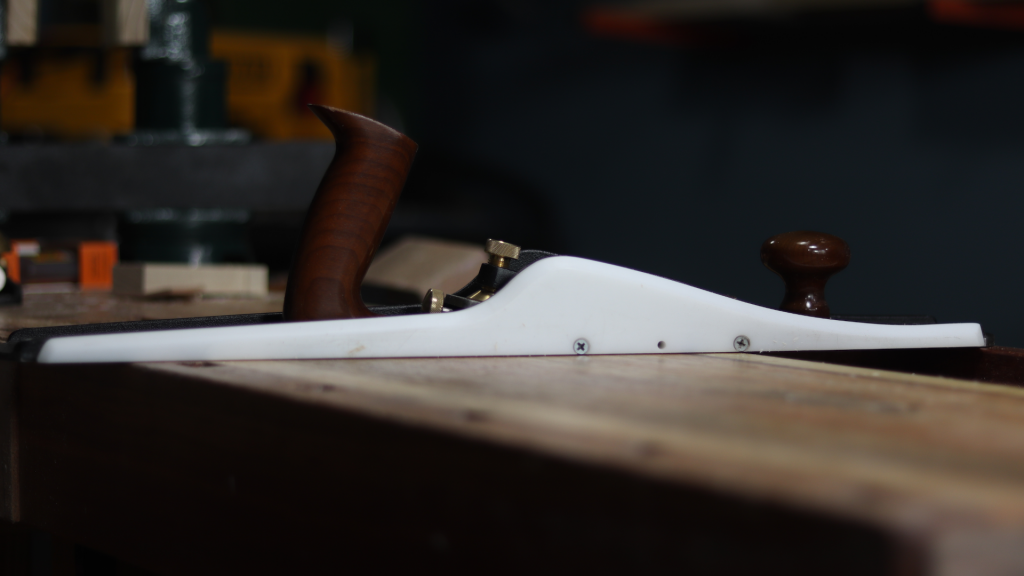
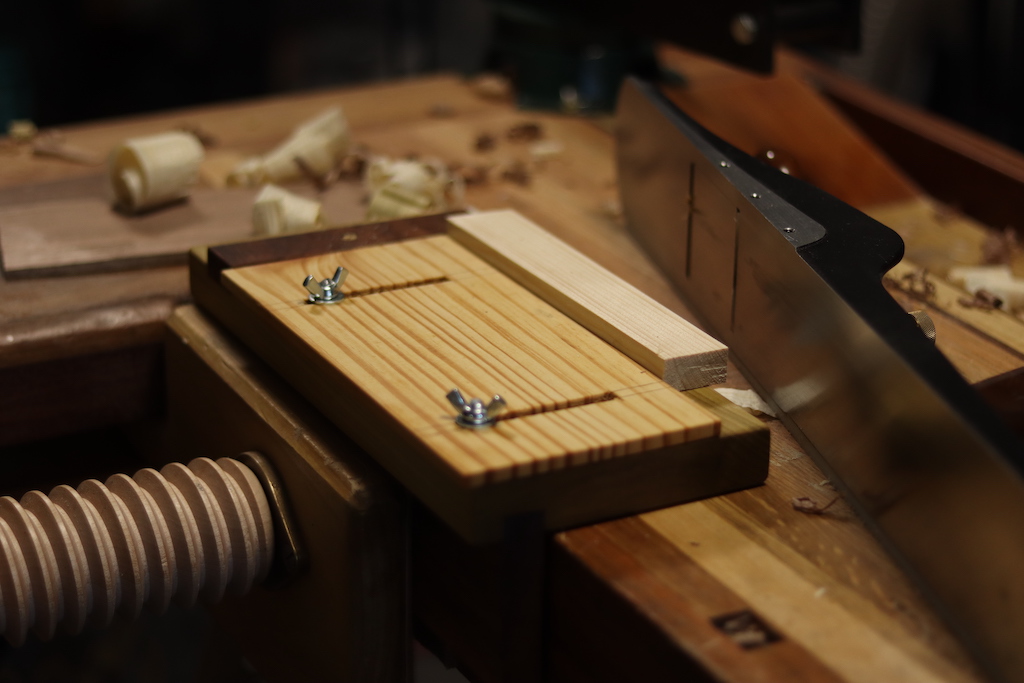
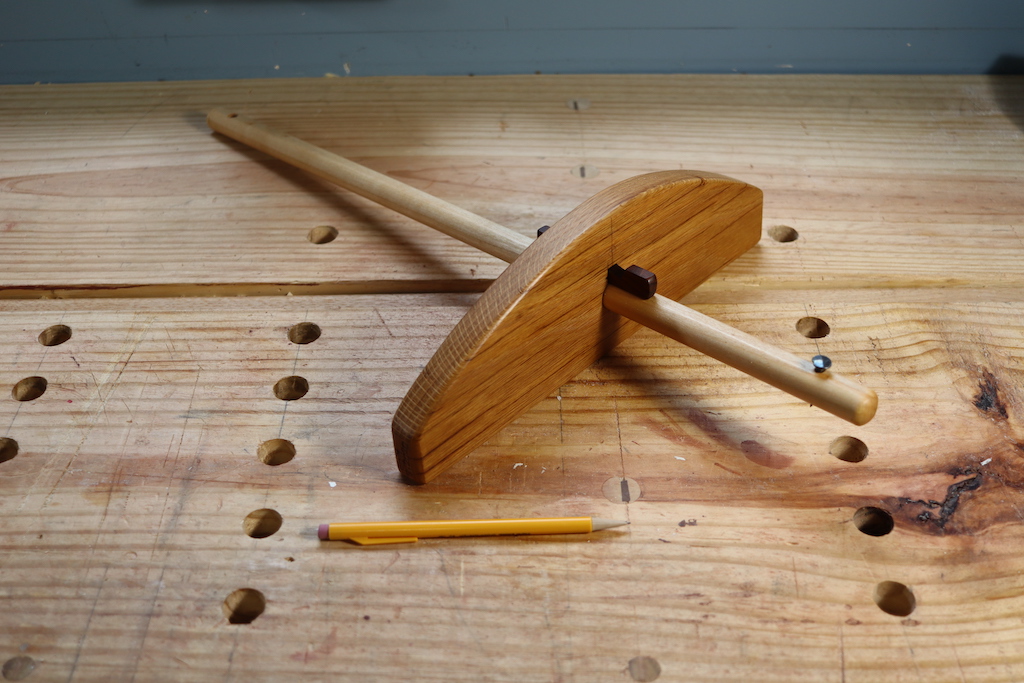
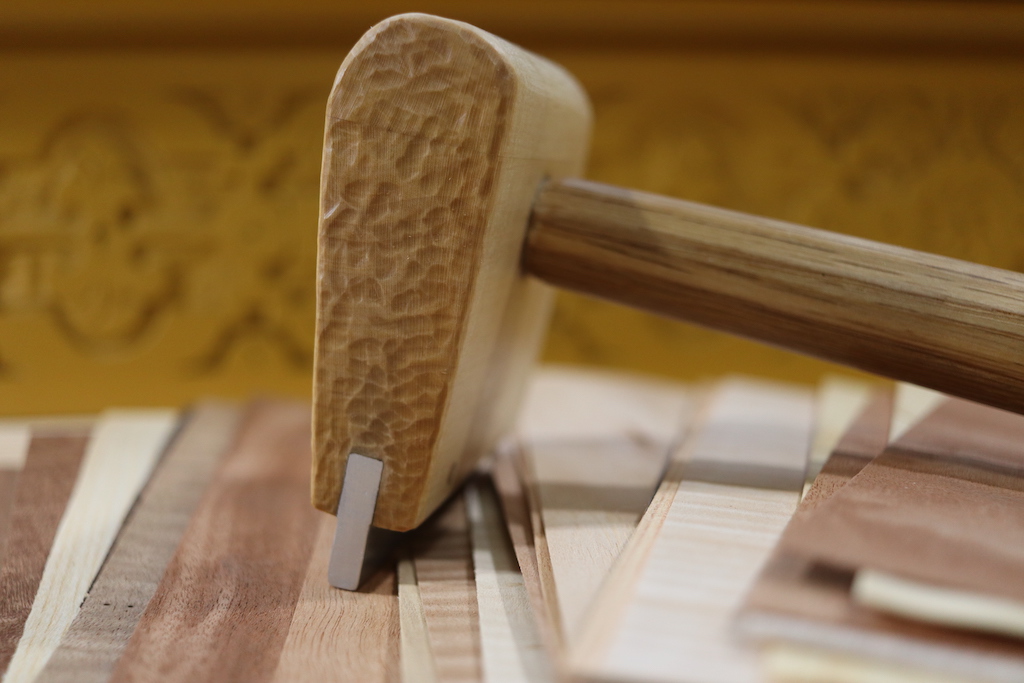
Question #20
Tobias: What is the next piece you are going to build and why?
Eric: Great question… I have an ever growing list of projects that I want to do. Remaking my shooting board and building a downdraft sanding table have been on the list for a while now, but things that are way more fun keep jumping the queue.
I want to build a Shaker style candle stand or sewing table with two drawers, although I am still figuring out how to do the center post without a lathe. I have been playing with the idea of building a lowboy and have begun my research. I would like to build this piece, whilst staying true to the way the original makers would have built them at the time. The thing that is keeping me from just jumping into this project, is that the examples I am finding are more decorative than my usual aesthetic. I am drawn more toward the subdued, utilitarian and vernacular forms. Basically, I am looking for a plainer version to “clone”. A “country” lowboy if you will. If anyone can point me in the right direction, please let me know!
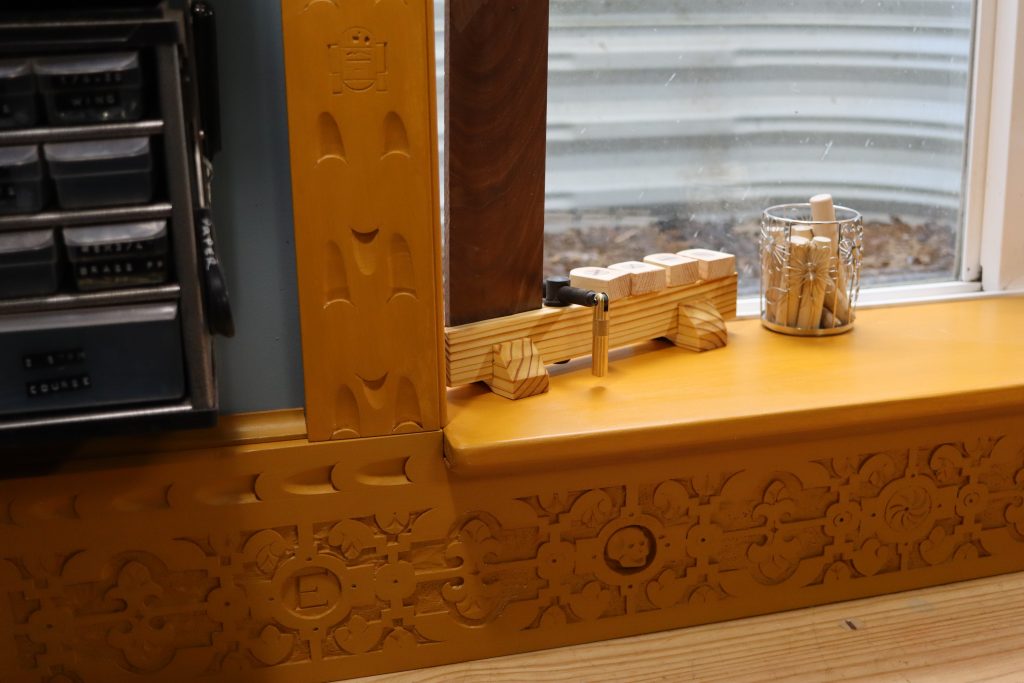
Tool Wishlist
- I have been wanting to get an ECE fenced dovetail plane, but I can never quite pull the trigger.
- A router table is on my list. I dislike using a router, but for the times when I would use it, a table would make it a more enjoyable and safer tool to use.
- A lathe! It seems that the furniture pieces that I have been wanting to build of late all have turned elements!
Lumber Wishlist
- Quarter-sawn Sycamore
- Utile/Sipo Mahogany
- Honduras Mahogany
- Knot-free quarter-sawn white pine
- Rainbow Poplar
- 8/4 Curly Soft Maple
- Hunk of quarter-sawn Beech for plane making
Makers with whom I would love to spend quality time
- Christian Becksvoort
- Gary Bennet
- Frank Klausz
- Jimmy Diresta
- Peter Follansbee
- Laura Kampf
Links
I have really enjoyed interviewing Eric. His approach to woodworking is something that many woodworkers aspire to.
Please remember, if you know of any woodworkers who are doing great work, yet are hiding away in their shops, please let us know at info@rarewoodsusa.com

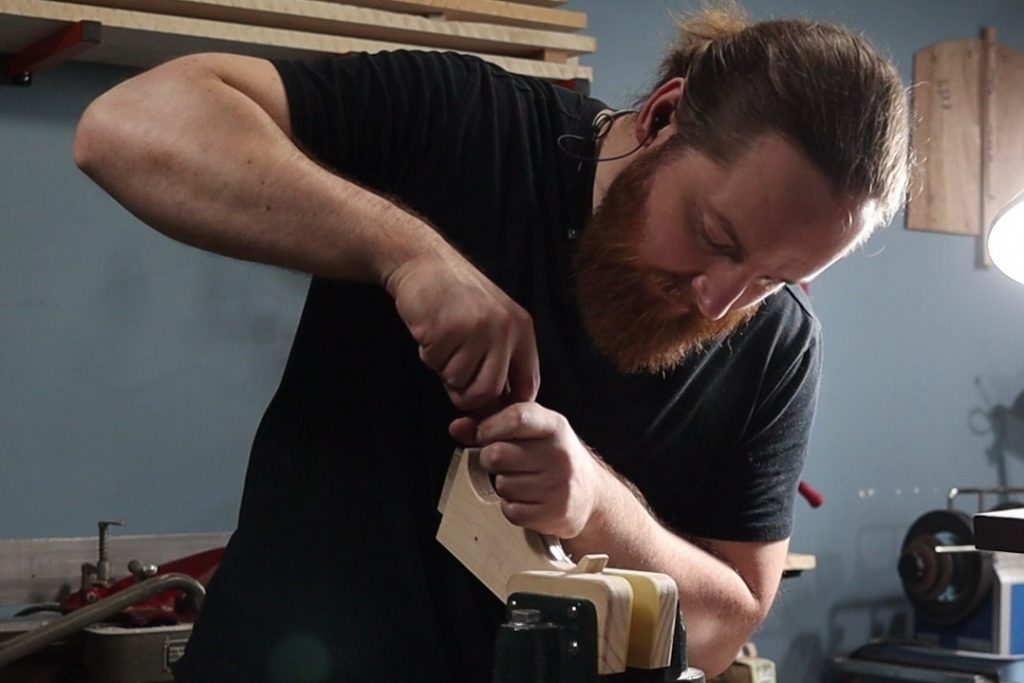
Really great to find a woodworker who is delving into the historical and traditional ways. More power to your elbow Eric! Thanks for a wonderful interview.